Leadership for Global Hospitality
VerifiedAdded on 2023/06/16
|19
|5148
|327
AI Summary
The report is the leadership portfolio and a compilation of twelve Leadership Skill Building exercises. The responses to the individual leadership tasks are composed as leadership portfolio. The leadership portfolio aims to explore the personal understanding about and readiness for leadership.
Contribute Materials
Your contribution can guide someone’s learning journey. Share your
documents today.
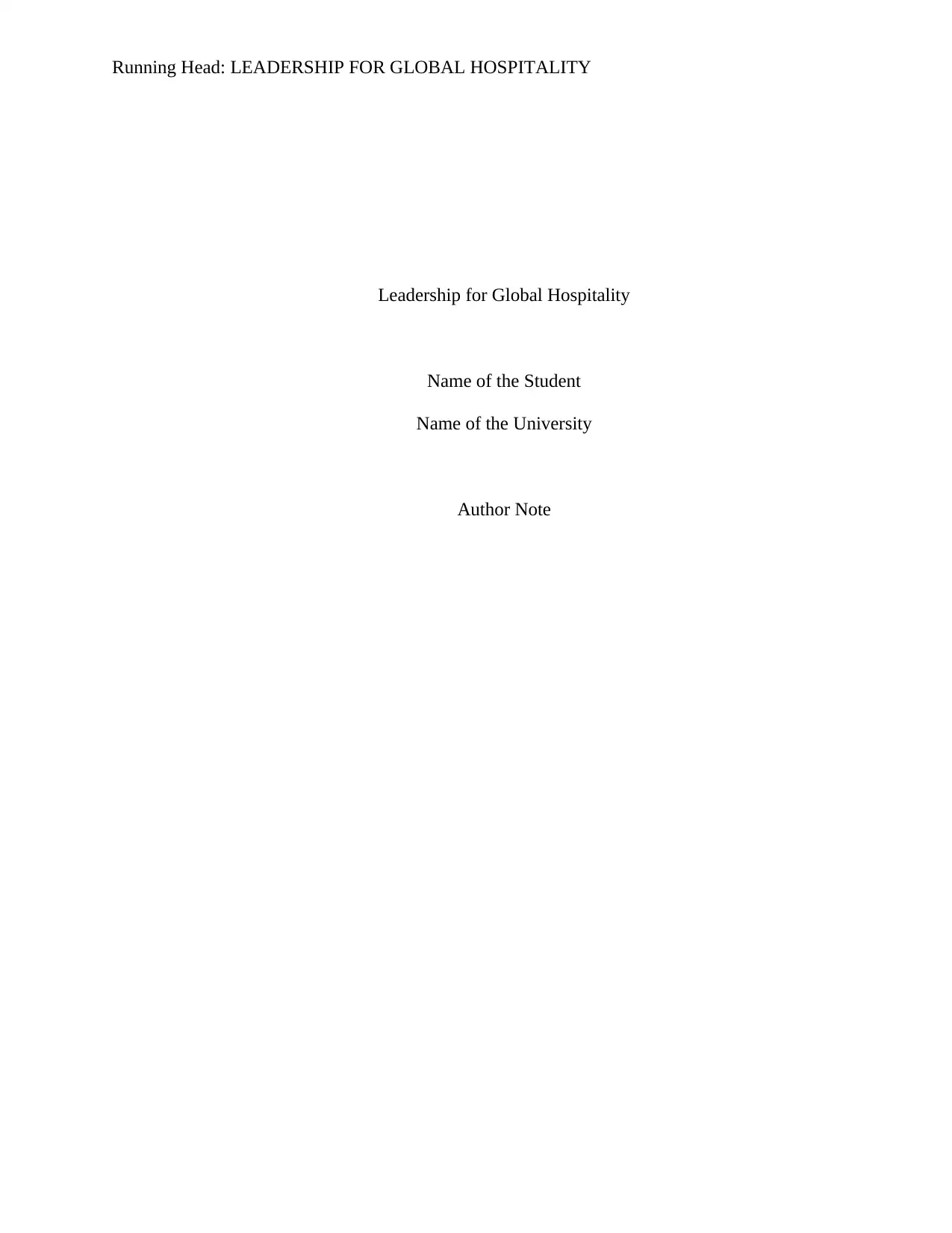
Running Head: LEADERSHIP FOR GLOBAL HOSPITALITY
Leadership for Global Hospitality
Name of the Student
Name of the University
Author Note
Leadership for Global Hospitality
Name of the Student
Name of the University
Author Note
Secure Best Marks with AI Grader
Need help grading? Try our AI Grader for instant feedback on your assignments.
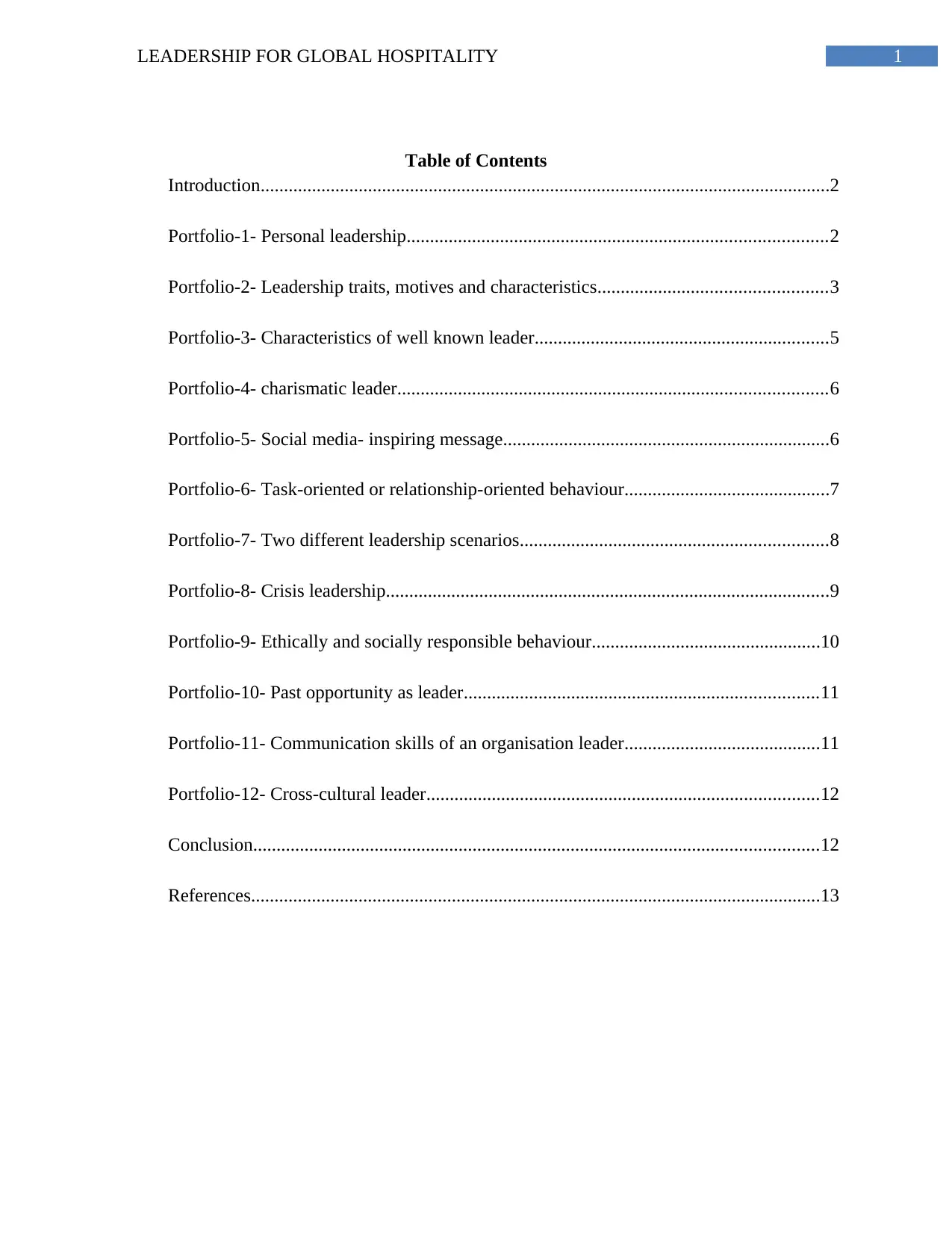
1LEADERSHIP FOR GLOBAL HOSPITALITY
Table of Contents
Introduction..........................................................................................................................2
Portfolio-1- Personal leadership..........................................................................................2
Portfolio-2- Leadership traits, motives and characteristics.................................................3
Portfolio-3- Characteristics of well known leader...............................................................5
Portfolio-4- charismatic leader............................................................................................6
Portfolio-5- Social media- inspiring message......................................................................6
Portfolio-6- Task-oriented or relationship-oriented behaviour............................................7
Portfolio-7- Two different leadership scenarios..................................................................8
Portfolio-8- Crisis leadership...............................................................................................9
Portfolio-9- Ethically and socially responsible behaviour.................................................10
Portfolio-10- Past opportunity as leader............................................................................11
Portfolio-11- Communication skills of an organisation leader..........................................11
Portfolio-12- Cross-cultural leader....................................................................................12
Conclusion.........................................................................................................................12
References..........................................................................................................................13
Table of Contents
Introduction..........................................................................................................................2
Portfolio-1- Personal leadership..........................................................................................2
Portfolio-2- Leadership traits, motives and characteristics.................................................3
Portfolio-3- Characteristics of well known leader...............................................................5
Portfolio-4- charismatic leader............................................................................................6
Portfolio-5- Social media- inspiring message......................................................................6
Portfolio-6- Task-oriented or relationship-oriented behaviour............................................7
Portfolio-7- Two different leadership scenarios..................................................................8
Portfolio-8- Crisis leadership...............................................................................................9
Portfolio-9- Ethically and socially responsible behaviour.................................................10
Portfolio-10- Past opportunity as leader............................................................................11
Portfolio-11- Communication skills of an organisation leader..........................................11
Portfolio-12- Cross-cultural leader....................................................................................12
Conclusion.........................................................................................................................12
References..........................................................................................................................13
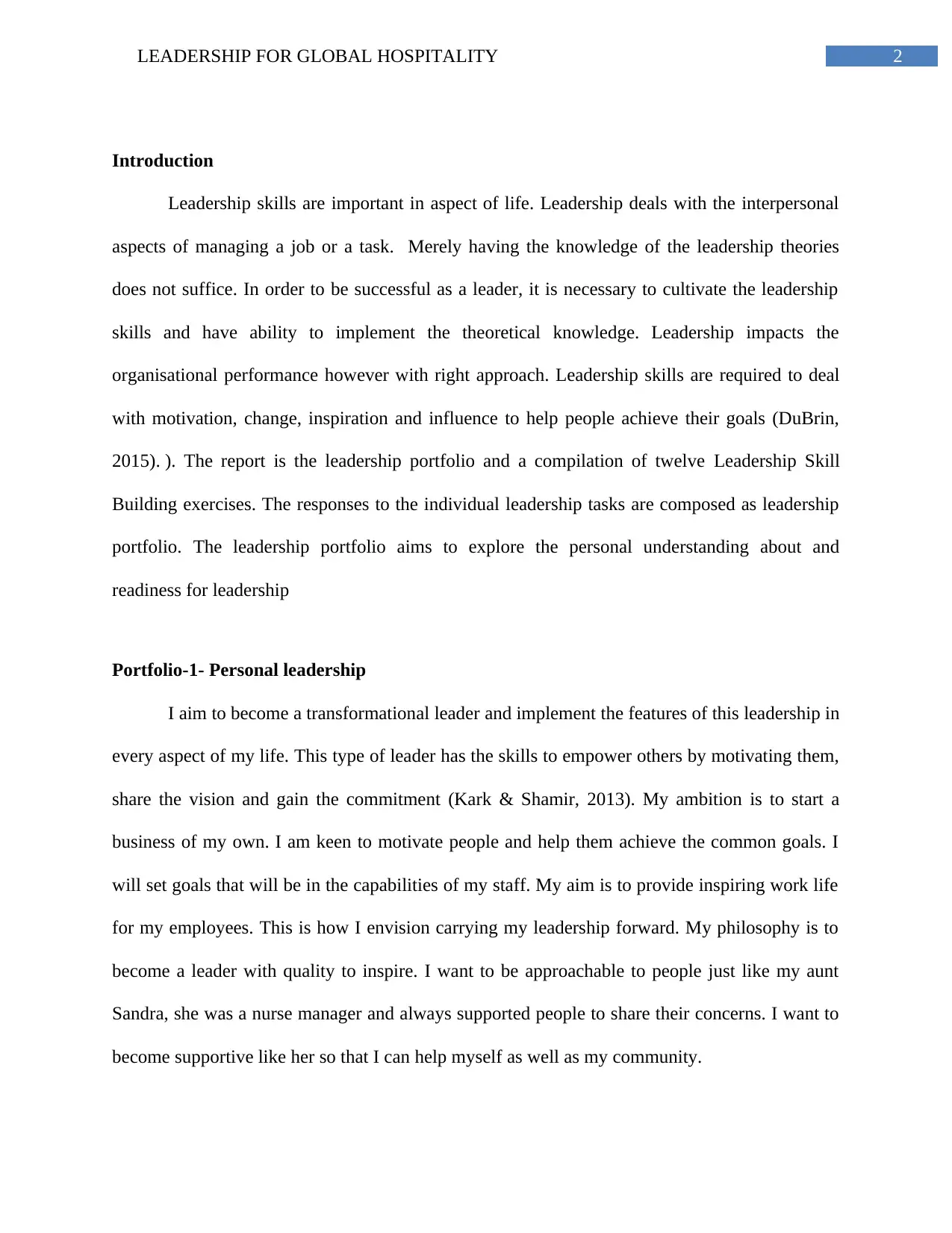
2LEADERSHIP FOR GLOBAL HOSPITALITY
Introduction
Leadership skills are important in aspect of life. Leadership deals with the interpersonal
aspects of managing a job or a task. Merely having the knowledge of the leadership theories
does not suffice. In order to be successful as a leader, it is necessary to cultivate the leadership
skills and have ability to implement the theoretical knowledge. Leadership impacts the
organisational performance however with right approach. Leadership skills are required to deal
with motivation, change, inspiration and influence to help people achieve their goals (DuBrin,
2015). ). The report is the leadership portfolio and a compilation of twelve Leadership Skill
Building exercises. The responses to the individual leadership tasks are composed as leadership
portfolio. The leadership portfolio aims to explore the personal understanding about and
readiness for leadership
Portfolio-1- Personal leadership
I aim to become a transformational leader and implement the features of this leadership in
every aspect of my life. This type of leader has the skills to empower others by motivating them,
share the vision and gain the commitment (Kark & Shamir, 2013). My ambition is to start a
business of my own. I am keen to motivate people and help them achieve the common goals. I
will set goals that will be in the capabilities of my staff. My aim is to provide inspiring work life
for my employees. This is how I envision carrying my leadership forward. My philosophy is to
become a leader with quality to inspire. I want to be approachable to people just like my aunt
Sandra, she was a nurse manager and always supported people to share their concerns. I want to
become supportive like her so that I can help myself as well as my community.
Introduction
Leadership skills are important in aspect of life. Leadership deals with the interpersonal
aspects of managing a job or a task. Merely having the knowledge of the leadership theories
does not suffice. In order to be successful as a leader, it is necessary to cultivate the leadership
skills and have ability to implement the theoretical knowledge. Leadership impacts the
organisational performance however with right approach. Leadership skills are required to deal
with motivation, change, inspiration and influence to help people achieve their goals (DuBrin,
2015). ). The report is the leadership portfolio and a compilation of twelve Leadership Skill
Building exercises. The responses to the individual leadership tasks are composed as leadership
portfolio. The leadership portfolio aims to explore the personal understanding about and
readiness for leadership
Portfolio-1- Personal leadership
I aim to become a transformational leader and implement the features of this leadership in
every aspect of my life. This type of leader has the skills to empower others by motivating them,
share the vision and gain the commitment (Kark & Shamir, 2013). My ambition is to start a
business of my own. I am keen to motivate people and help them achieve the common goals. I
will set goals that will be in the capabilities of my staff. My aim is to provide inspiring work life
for my employees. This is how I envision carrying my leadership forward. My philosophy is to
become a leader with quality to inspire. I want to be approachable to people just like my aunt
Sandra, she was a nurse manager and always supported people to share their concerns. I want to
become supportive like her so that I can help myself as well as my community.
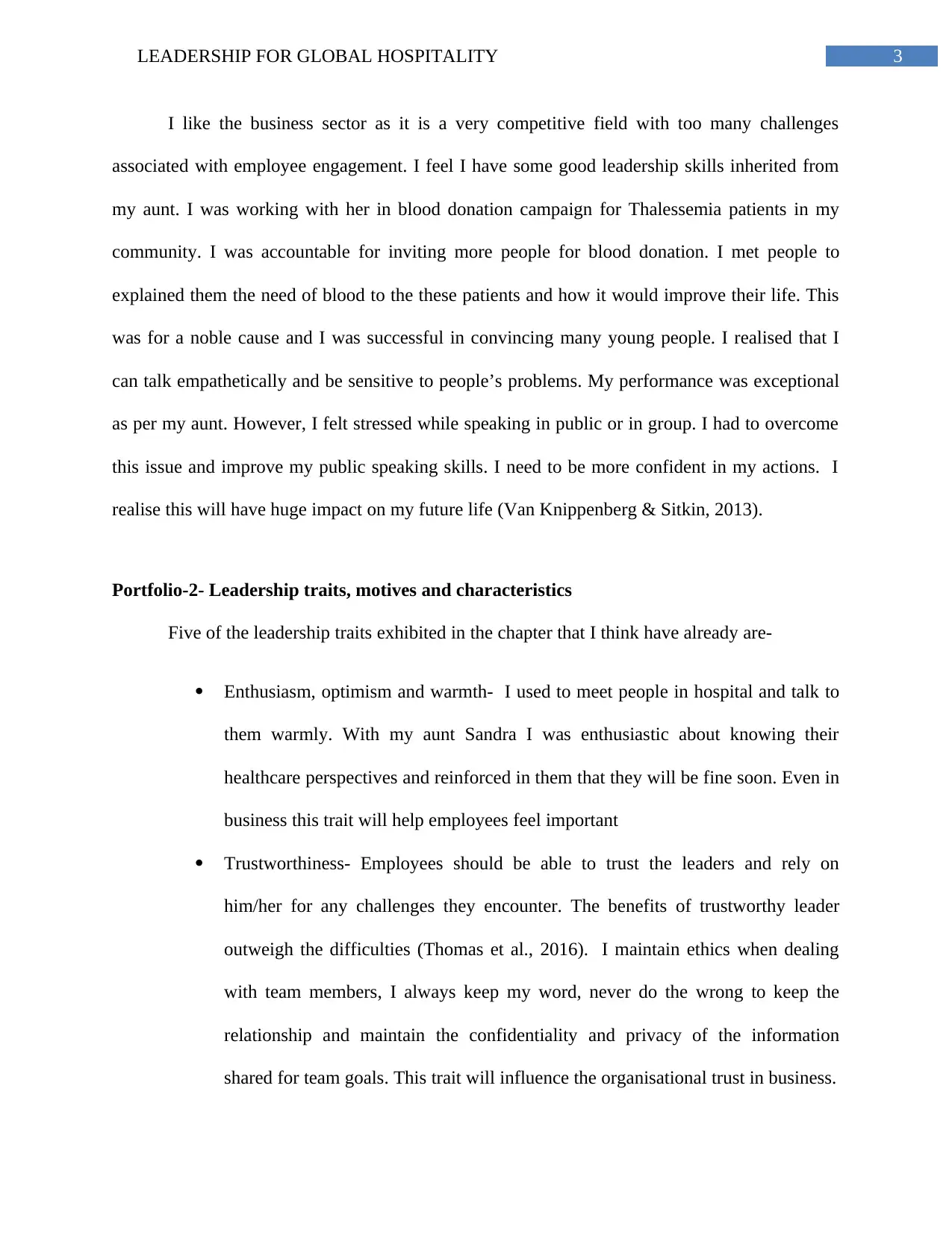
3LEADERSHIP FOR GLOBAL HOSPITALITY
I like the business sector as it is a very competitive field with too many challenges
associated with employee engagement. I feel I have some good leadership skills inherited from
my aunt. I was working with her in blood donation campaign for Thalessemia patients in my
community. I was accountable for inviting more people for blood donation. I met people to
explained them the need of blood to the these patients and how it would improve their life. This
was for a noble cause and I was successful in convincing many young people. I realised that I
can talk empathetically and be sensitive to people’s problems. My performance was exceptional
as per my aunt. However, I felt stressed while speaking in public or in group. I had to overcome
this issue and improve my public speaking skills. I need to be more confident in my actions. I
realise this will have huge impact on my future life (Van Knippenberg & Sitkin, 2013).
Portfolio-2- Leadership traits, motives and characteristics
Five of the leadership traits exhibited in the chapter that I think have already are-
Enthusiasm, optimism and warmth- I used to meet people in hospital and talk to
them warmly. With my aunt Sandra I was enthusiastic about knowing their
healthcare perspectives and reinforced in them that they will be fine soon. Even in
business this trait will help employees feel important
Trustworthiness- Employees should be able to trust the leaders and rely on
him/her for any challenges they encounter. The benefits of trustworthy leader
outweigh the difficulties (Thomas et al., 2016). I maintain ethics when dealing
with team members, I always keep my word, never do the wrong to keep the
relationship and maintain the confidentiality and privacy of the information
shared for team goals. This trait will influence the organisational trust in business.
I like the business sector as it is a very competitive field with too many challenges
associated with employee engagement. I feel I have some good leadership skills inherited from
my aunt. I was working with her in blood donation campaign for Thalessemia patients in my
community. I was accountable for inviting more people for blood donation. I met people to
explained them the need of blood to the these patients and how it would improve their life. This
was for a noble cause and I was successful in convincing many young people. I realised that I
can talk empathetically and be sensitive to people’s problems. My performance was exceptional
as per my aunt. However, I felt stressed while speaking in public or in group. I had to overcome
this issue and improve my public speaking skills. I need to be more confident in my actions. I
realise this will have huge impact on my future life (Van Knippenberg & Sitkin, 2013).
Portfolio-2- Leadership traits, motives and characteristics
Five of the leadership traits exhibited in the chapter that I think have already are-
Enthusiasm, optimism and warmth- I used to meet people in hospital and talk to
them warmly. With my aunt Sandra I was enthusiastic about knowing their
healthcare perspectives and reinforced in them that they will be fine soon. Even in
business this trait will help employees feel important
Trustworthiness- Employees should be able to trust the leaders and rely on
him/her for any challenges they encounter. The benefits of trustworthy leader
outweigh the difficulties (Thomas et al., 2016). I maintain ethics when dealing
with team members, I always keep my word, never do the wrong to keep the
relationship and maintain the confidentiality and privacy of the information
shared for team goals. This trait will influence the organisational trust in business.
Paraphrase This Document
Need a fresh take? Get an instant paraphrase of this document with our AI Paraphraser
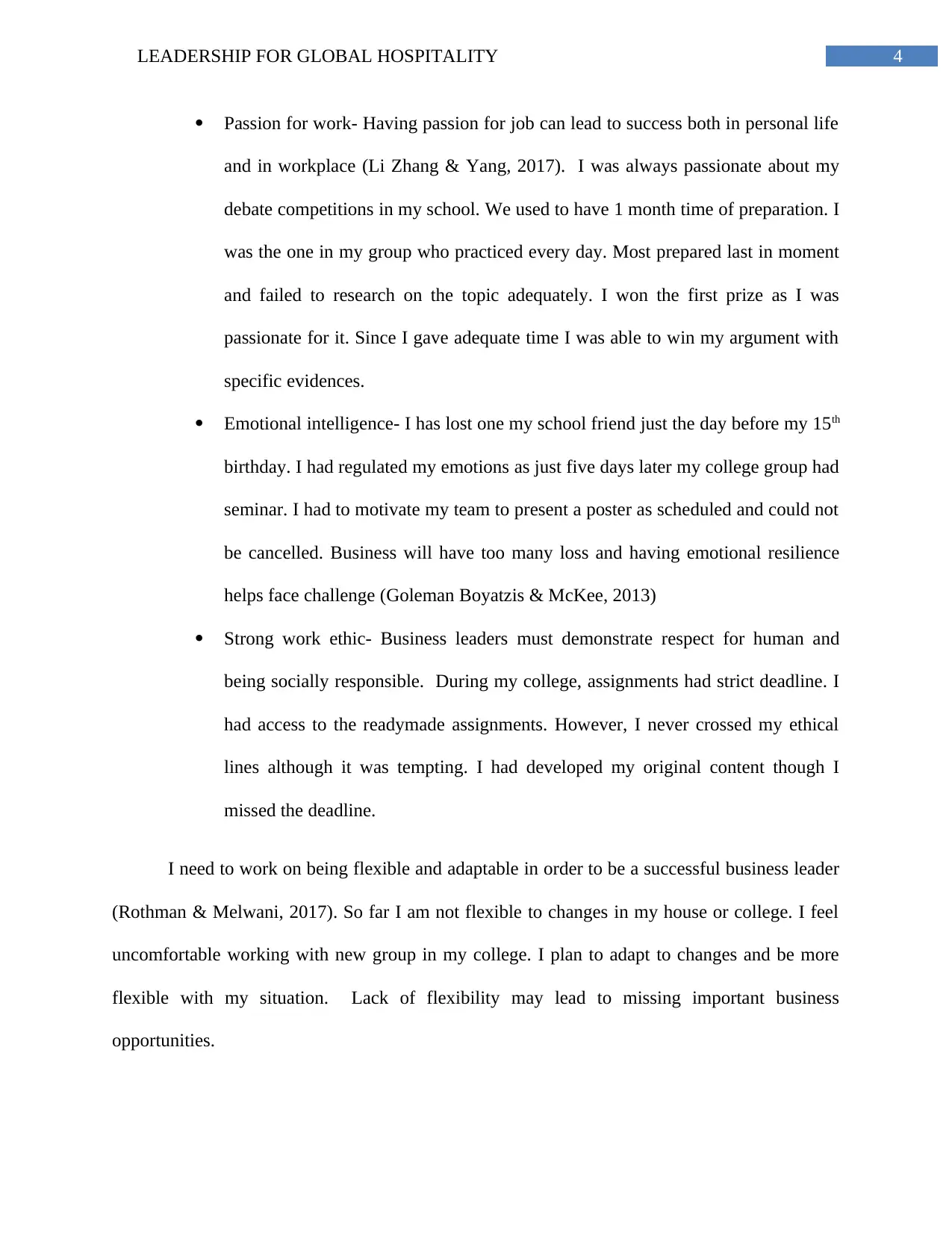
4LEADERSHIP FOR GLOBAL HOSPITALITY
Passion for work- Having passion for job can lead to success both in personal life
and in workplace (Li Zhang & Yang, 2017). I was always passionate about my
debate competitions in my school. We used to have 1 month time of preparation. I
was the one in my group who practiced every day. Most prepared last in moment
and failed to research on the topic adequately. I won the first prize as I was
passionate for it. Since I gave adequate time I was able to win my argument with
specific evidences.
Emotional intelligence- I has lost one my school friend just the day before my 15th
birthday. I had regulated my emotions as just five days later my college group had
seminar. I had to motivate my team to present a poster as scheduled and could not
be cancelled. Business will have too many loss and having emotional resilience
helps face challenge (Goleman Boyatzis & McKee, 2013)
Strong work ethic- Business leaders must demonstrate respect for human and
being socially responsible. During my college, assignments had strict deadline. I
had access to the readymade assignments. However, I never crossed my ethical
lines although it was tempting. I had developed my original content though I
missed the deadline.
I need to work on being flexible and adaptable in order to be a successful business leader
(Rothman & Melwani, 2017). So far I am not flexible to changes in my house or college. I feel
uncomfortable working with new group in my college. I plan to adapt to changes and be more
flexible with my situation. Lack of flexibility may lead to missing important business
opportunities.
Passion for work- Having passion for job can lead to success both in personal life
and in workplace (Li Zhang & Yang, 2017). I was always passionate about my
debate competitions in my school. We used to have 1 month time of preparation. I
was the one in my group who practiced every day. Most prepared last in moment
and failed to research on the topic adequately. I won the first prize as I was
passionate for it. Since I gave adequate time I was able to win my argument with
specific evidences.
Emotional intelligence- I has lost one my school friend just the day before my 15th
birthday. I had regulated my emotions as just five days later my college group had
seminar. I had to motivate my team to present a poster as scheduled and could not
be cancelled. Business will have too many loss and having emotional resilience
helps face challenge (Goleman Boyatzis & McKee, 2013)
Strong work ethic- Business leaders must demonstrate respect for human and
being socially responsible. During my college, assignments had strict deadline. I
had access to the readymade assignments. However, I never crossed my ethical
lines although it was tempting. I had developed my original content though I
missed the deadline.
I need to work on being flexible and adaptable in order to be a successful business leader
(Rothman & Melwani, 2017). So far I am not flexible to changes in my house or college. I feel
uncomfortable working with new group in my college. I plan to adapt to changes and be more
flexible with my situation. Lack of flexibility may lead to missing important business
opportunities.
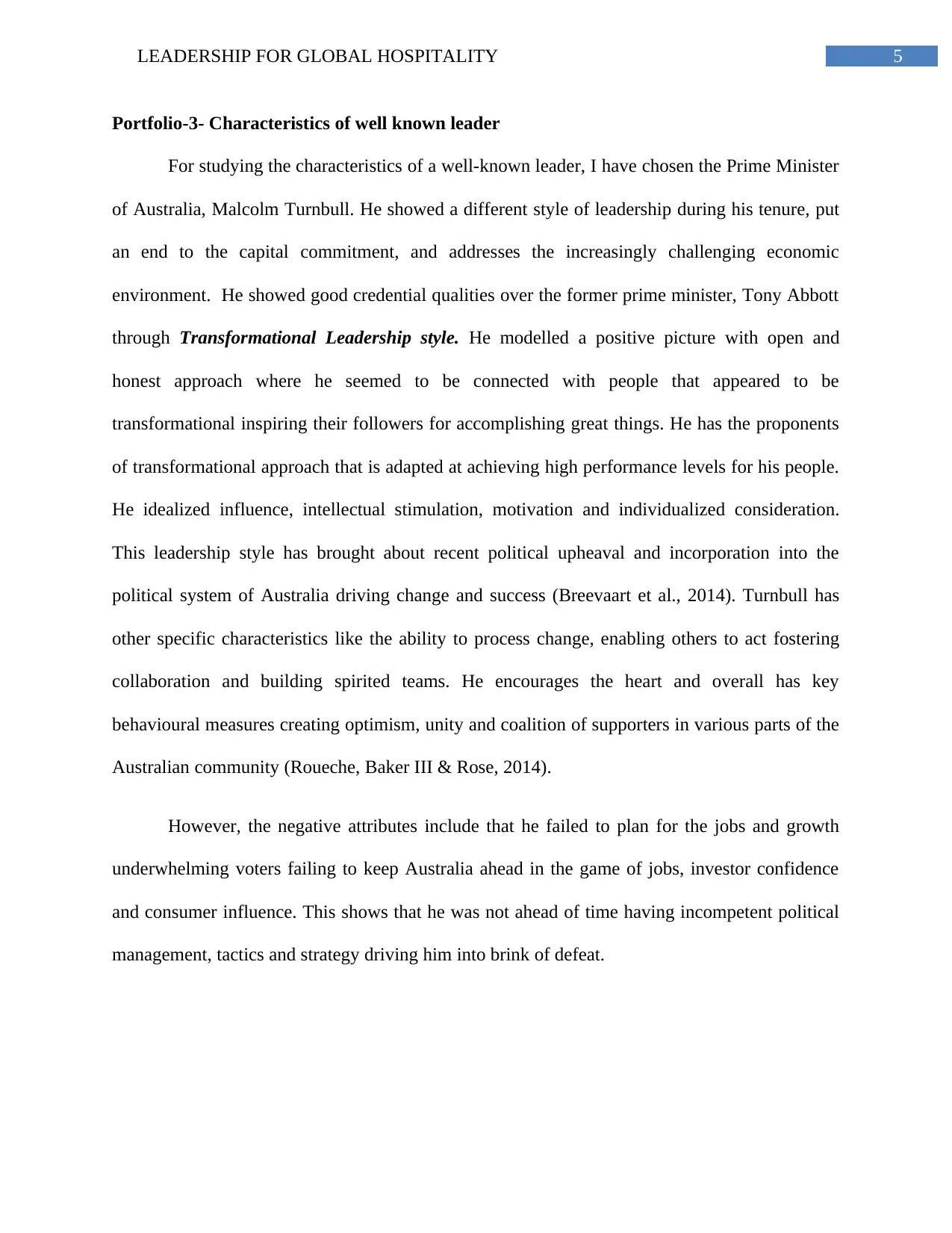
5LEADERSHIP FOR GLOBAL HOSPITALITY
Portfolio-3- Characteristics of well known leader
For studying the characteristics of a well-known leader, I have chosen the Prime Minister
of Australia, Malcolm Turnbull. He showed a different style of leadership during his tenure, put
an end to the capital commitment, and addresses the increasingly challenging economic
environment. He showed good credential qualities over the former prime minister, Tony Abbott
through Transformational Leadership style. He modelled a positive picture with open and
honest approach where he seemed to be connected with people that appeared to be
transformational inspiring their followers for accomplishing great things. He has the proponents
of transformational approach that is adapted at achieving high performance levels for his people.
He idealized influence, intellectual stimulation, motivation and individualized consideration.
This leadership style has brought about recent political upheaval and incorporation into the
political system of Australia driving change and success (Breevaart et al., 2014). Turnbull has
other specific characteristics like the ability to process change, enabling others to act fostering
collaboration and building spirited teams. He encourages the heart and overall has key
behavioural measures creating optimism, unity and coalition of supporters in various parts of the
Australian community (Roueche, Baker III & Rose, 2014).
However, the negative attributes include that he failed to plan for the jobs and growth
underwhelming voters failing to keep Australia ahead in the game of jobs, investor confidence
and consumer influence. This shows that he was not ahead of time having incompetent political
management, tactics and strategy driving him into brink of defeat.
Portfolio-3- Characteristics of well known leader
For studying the characteristics of a well-known leader, I have chosen the Prime Minister
of Australia, Malcolm Turnbull. He showed a different style of leadership during his tenure, put
an end to the capital commitment, and addresses the increasingly challenging economic
environment. He showed good credential qualities over the former prime minister, Tony Abbott
through Transformational Leadership style. He modelled a positive picture with open and
honest approach where he seemed to be connected with people that appeared to be
transformational inspiring their followers for accomplishing great things. He has the proponents
of transformational approach that is adapted at achieving high performance levels for his people.
He idealized influence, intellectual stimulation, motivation and individualized consideration.
This leadership style has brought about recent political upheaval and incorporation into the
political system of Australia driving change and success (Breevaart et al., 2014). Turnbull has
other specific characteristics like the ability to process change, enabling others to act fostering
collaboration and building spirited teams. He encourages the heart and overall has key
behavioural measures creating optimism, unity and coalition of supporters in various parts of the
Australian community (Roueche, Baker III & Rose, 2014).
However, the negative attributes include that he failed to plan for the jobs and growth
underwhelming voters failing to keep Australia ahead in the game of jobs, investor confidence
and consumer influence. This shows that he was not ahead of time having incompetent political
management, tactics and strategy driving him into brink of defeat.
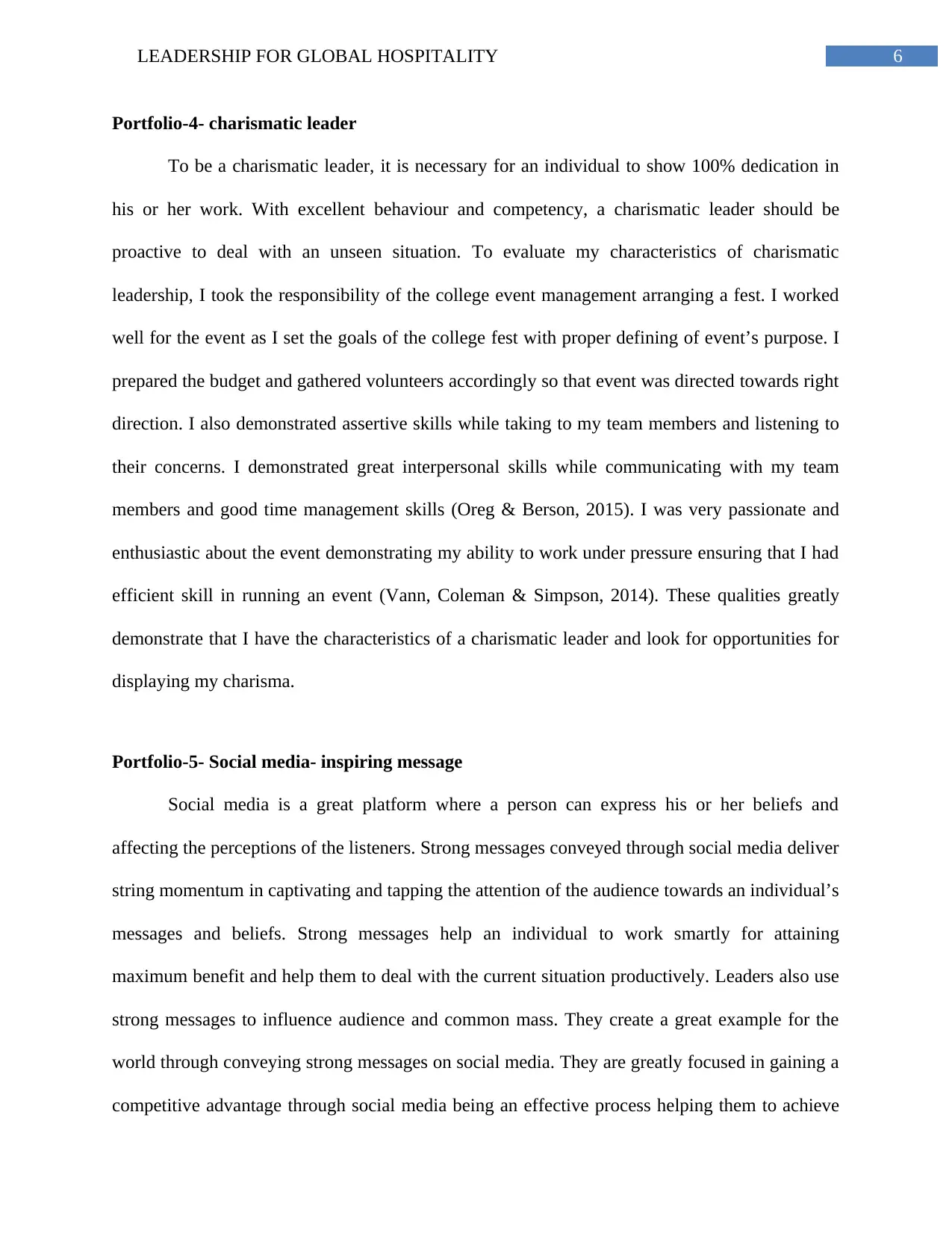
6LEADERSHIP FOR GLOBAL HOSPITALITY
Portfolio-4- charismatic leader
To be a charismatic leader, it is necessary for an individual to show 100% dedication in
his or her work. With excellent behaviour and competency, a charismatic leader should be
proactive to deal with an unseen situation. To evaluate my characteristics of charismatic
leadership, I took the responsibility of the college event management arranging a fest. I worked
well for the event as I set the goals of the college fest with proper defining of event’s purpose. I
prepared the budget and gathered volunteers accordingly so that event was directed towards right
direction. I also demonstrated assertive skills while taking to my team members and listening to
their concerns. I demonstrated great interpersonal skills while communicating with my team
members and good time management skills (Oreg & Berson, 2015). I was very passionate and
enthusiastic about the event demonstrating my ability to work under pressure ensuring that I had
efficient skill in running an event (Vann, Coleman & Simpson, 2014). These qualities greatly
demonstrate that I have the characteristics of a charismatic leader and look for opportunities for
displaying my charisma.
Portfolio-5- Social media- inspiring message
Social media is a great platform where a person can express his or her beliefs and
affecting the perceptions of the listeners. Strong messages conveyed through social media deliver
string momentum in captivating and tapping the attention of the audience towards an individual’s
messages and beliefs. Strong messages help an individual to work smartly for attaining
maximum benefit and help them to deal with the current situation productively. Leaders also use
strong messages to influence audience and common mass. They create a great example for the
world through conveying strong messages on social media. They are greatly focused in gaining a
competitive advantage through social media being an effective process helping them to achieve
Portfolio-4- charismatic leader
To be a charismatic leader, it is necessary for an individual to show 100% dedication in
his or her work. With excellent behaviour and competency, a charismatic leader should be
proactive to deal with an unseen situation. To evaluate my characteristics of charismatic
leadership, I took the responsibility of the college event management arranging a fest. I worked
well for the event as I set the goals of the college fest with proper defining of event’s purpose. I
prepared the budget and gathered volunteers accordingly so that event was directed towards right
direction. I also demonstrated assertive skills while taking to my team members and listening to
their concerns. I demonstrated great interpersonal skills while communicating with my team
members and good time management skills (Oreg & Berson, 2015). I was very passionate and
enthusiastic about the event demonstrating my ability to work under pressure ensuring that I had
efficient skill in running an event (Vann, Coleman & Simpson, 2014). These qualities greatly
demonstrate that I have the characteristics of a charismatic leader and look for opportunities for
displaying my charisma.
Portfolio-5- Social media- inspiring message
Social media is a great platform where a person can express his or her beliefs and
affecting the perceptions of the listeners. Strong messages conveyed through social media deliver
string momentum in captivating and tapping the attention of the audience towards an individual’s
messages and beliefs. Strong messages help an individual to work smartly for attaining
maximum benefit and help them to deal with the current situation productively. Leaders also use
strong messages to influence audience and common mass. They create a great example for the
world through conveying strong messages on social media. They are greatly focused in gaining a
competitive advantage through social media being an effective process helping them to achieve
Secure Best Marks with AI Grader
Need help grading? Try our AI Grader for instant feedback on your assignments.
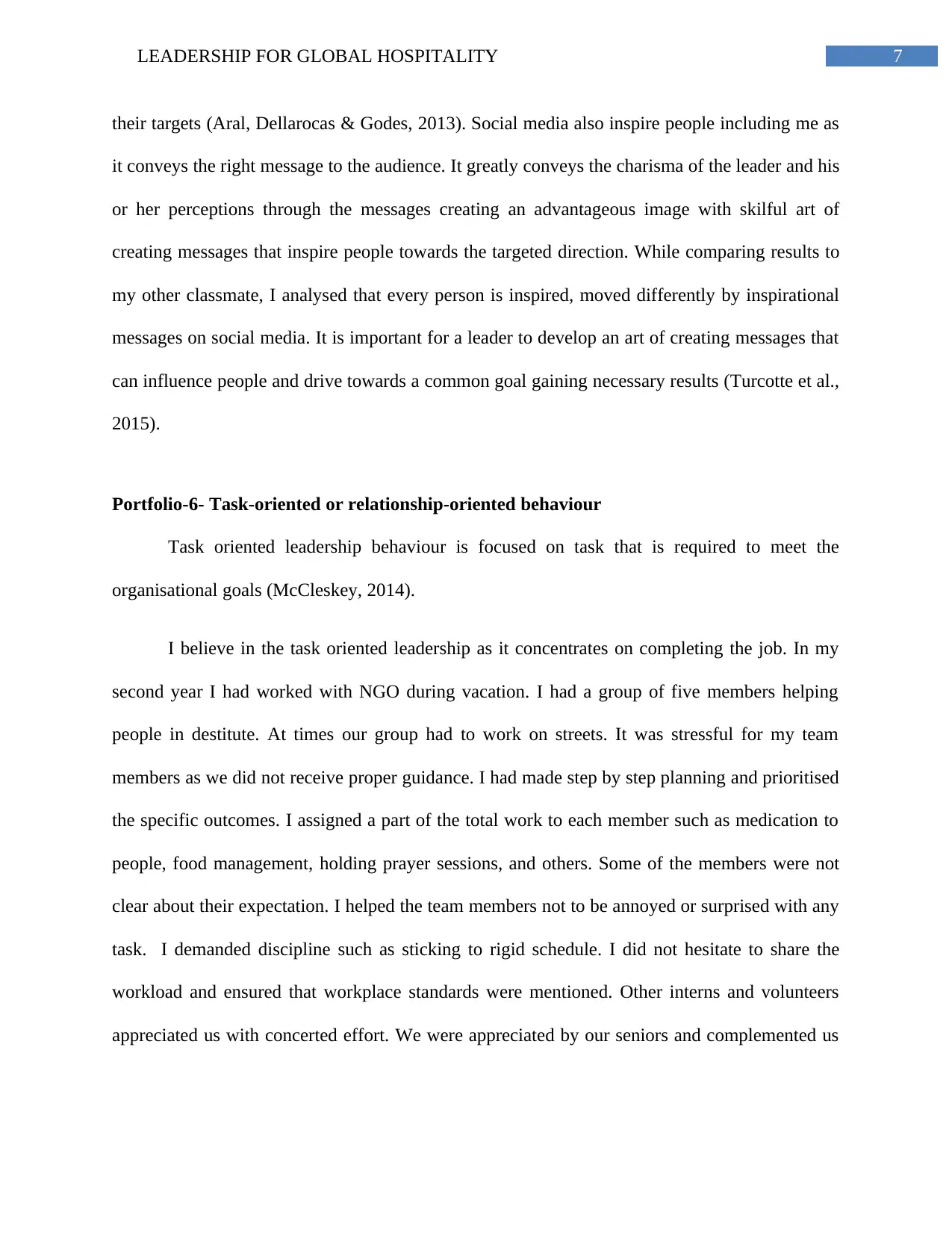
7LEADERSHIP FOR GLOBAL HOSPITALITY
their targets (Aral, Dellarocas & Godes, 2013). Social media also inspire people including me as
it conveys the right message to the audience. It greatly conveys the charisma of the leader and his
or her perceptions through the messages creating an advantageous image with skilful art of
creating messages that inspire people towards the targeted direction. While comparing results to
my other classmate, I analysed that every person is inspired, moved differently by inspirational
messages on social media. It is important for a leader to develop an art of creating messages that
can influence people and drive towards a common goal gaining necessary results (Turcotte et al.,
2015).
Portfolio-6- Task-oriented or relationship-oriented behaviour
Task oriented leadership behaviour is focused on task that is required to meet the
organisational goals (McCleskey, 2014).
I believe in the task oriented leadership as it concentrates on completing the job. In my
second year I had worked with NGO during vacation. I had a group of five members helping
people in destitute. At times our group had to work on streets. It was stressful for my team
members as we did not receive proper guidance. I had made step by step planning and prioritised
the specific outcomes. I assigned a part of the total work to each member such as medication to
people, food management, holding prayer sessions, and others. Some of the members were not
clear about their expectation. I helped the team members not to be annoyed or surprised with any
task. I demanded discipline such as sticking to rigid schedule. I did not hesitate to share the
workload and ensured that workplace standards were mentioned. Other interns and volunteers
appreciated us with concerted effort. We were appreciated by our seniors and complemented us
their targets (Aral, Dellarocas & Godes, 2013). Social media also inspire people including me as
it conveys the right message to the audience. It greatly conveys the charisma of the leader and his
or her perceptions through the messages creating an advantageous image with skilful art of
creating messages that inspire people towards the targeted direction. While comparing results to
my other classmate, I analysed that every person is inspired, moved differently by inspirational
messages on social media. It is important for a leader to develop an art of creating messages that
can influence people and drive towards a common goal gaining necessary results (Turcotte et al.,
2015).
Portfolio-6- Task-oriented or relationship-oriented behaviour
Task oriented leadership behaviour is focused on task that is required to meet the
organisational goals (McCleskey, 2014).
I believe in the task oriented leadership as it concentrates on completing the job. In my
second year I had worked with NGO during vacation. I had a group of five members helping
people in destitute. At times our group had to work on streets. It was stressful for my team
members as we did not receive proper guidance. I had made step by step planning and prioritised
the specific outcomes. I assigned a part of the total work to each member such as medication to
people, food management, holding prayer sessions, and others. Some of the members were not
clear about their expectation. I helped the team members not to be annoyed or surprised with any
task. I demanded discipline such as sticking to rigid schedule. I did not hesitate to share the
workload and ensured that workplace standards were mentioned. Other interns and volunteers
appreciated us with concerted effort. We were appreciated by our seniors and complemented us
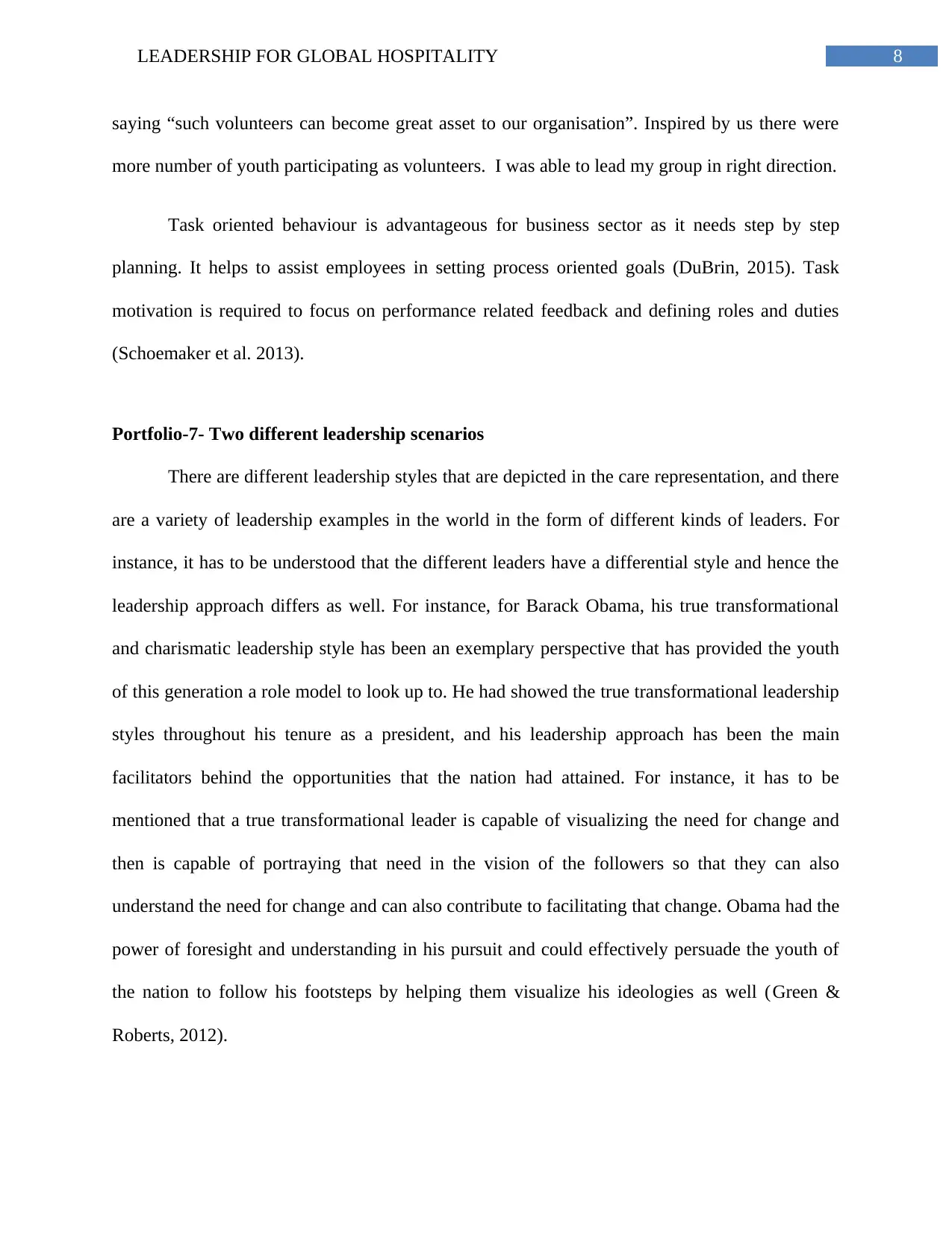
8LEADERSHIP FOR GLOBAL HOSPITALITY
saying “such volunteers can become great asset to our organisation”. Inspired by us there were
more number of youth participating as volunteers. I was able to lead my group in right direction.
Task oriented behaviour is advantageous for business sector as it needs step by step
planning. It helps to assist employees in setting process oriented goals (DuBrin, 2015). Task
motivation is required to focus on performance related feedback and defining roles and duties
(Schoemaker et al. 2013).
Portfolio-7- Two different leadership scenarios
There are different leadership styles that are depicted in the care representation, and there
are a variety of leadership examples in the world in the form of different kinds of leaders. For
instance, it has to be understood that the different leaders have a differential style and hence the
leadership approach differs as well. For instance, for Barack Obama, his true transformational
and charismatic leadership style has been an exemplary perspective that has provided the youth
of this generation a role model to look up to. He had showed the true transformational leadership
styles throughout his tenure as a president, and his leadership approach has been the main
facilitators behind the opportunities that the nation had attained. For instance, it has to be
mentioned that a true transformational leader is capable of visualizing the need for change and
then is capable of portraying that need in the vision of the followers so that they can also
understand the need for change and can also contribute to facilitating that change. Obama had the
power of foresight and understanding in his pursuit and could effectively persuade the youth of
the nation to follow his footsteps by helping them visualize his ideologies as well (Green &
Roberts, 2012).
saying “such volunteers can become great asset to our organisation”. Inspired by us there were
more number of youth participating as volunteers. I was able to lead my group in right direction.
Task oriented behaviour is advantageous for business sector as it needs step by step
planning. It helps to assist employees in setting process oriented goals (DuBrin, 2015). Task
motivation is required to focus on performance related feedback and defining roles and duties
(Schoemaker et al. 2013).
Portfolio-7- Two different leadership scenarios
There are different leadership styles that are depicted in the care representation, and there
are a variety of leadership examples in the world in the form of different kinds of leaders. For
instance, it has to be understood that the different leaders have a differential style and hence the
leadership approach differs as well. For instance, for Barack Obama, his true transformational
and charismatic leadership style has been an exemplary perspective that has provided the youth
of this generation a role model to look up to. He had showed the true transformational leadership
styles throughout his tenure as a president, and his leadership approach has been the main
facilitators behind the opportunities that the nation had attained. For instance, it has to be
mentioned that a true transformational leader is capable of visualizing the need for change and
then is capable of portraying that need in the vision of the followers so that they can also
understand the need for change and can also contribute to facilitating that change. Obama had the
power of foresight and understanding in his pursuit and could effectively persuade the youth of
the nation to follow his footsteps by helping them visualize his ideologies as well (Green &
Roberts, 2012).
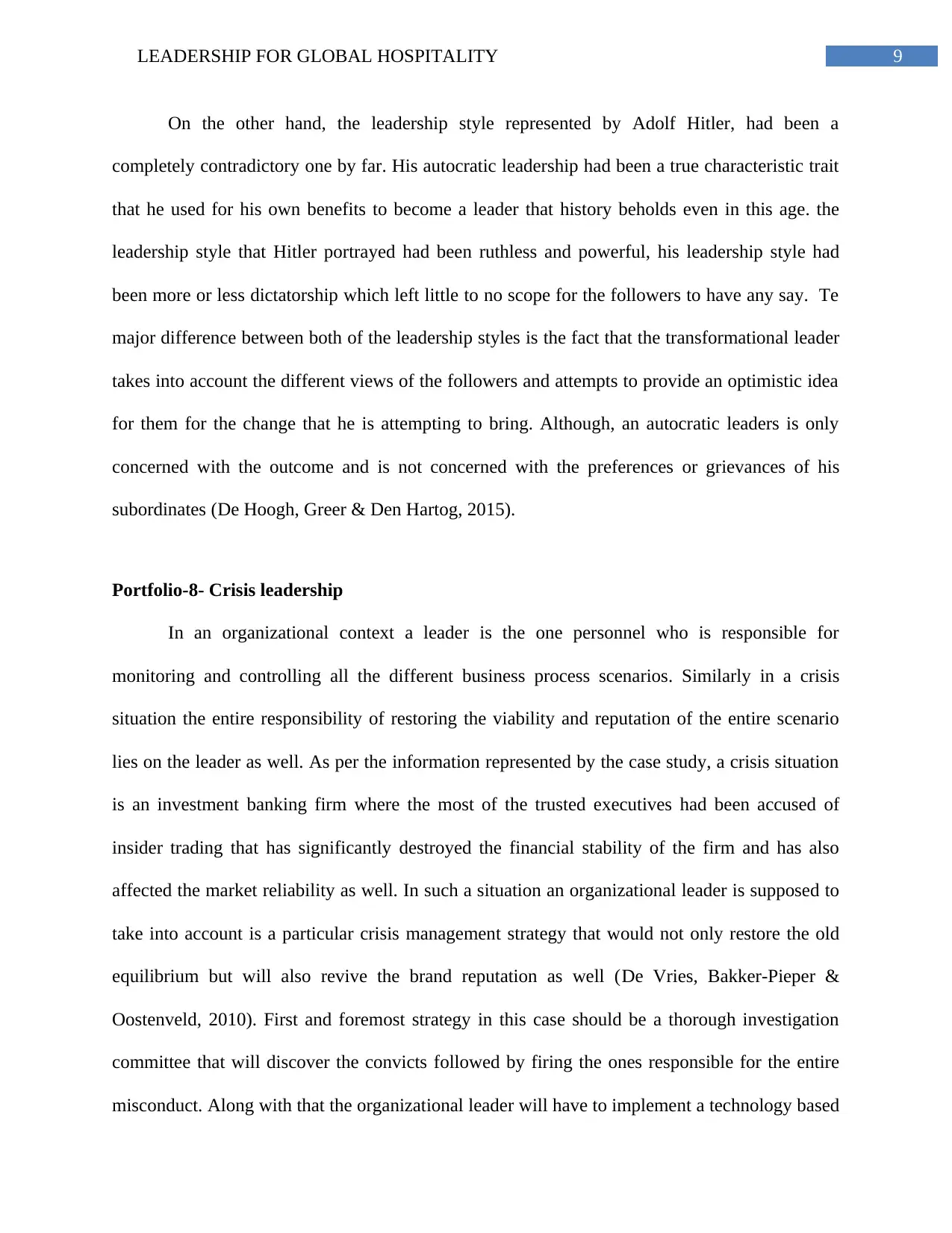
9LEADERSHIP FOR GLOBAL HOSPITALITY
On the other hand, the leadership style represented by Adolf Hitler, had been a
completely contradictory one by far. His autocratic leadership had been a true characteristic trait
that he used for his own benefits to become a leader that history beholds even in this age. the
leadership style that Hitler portrayed had been ruthless and powerful, his leadership style had
been more or less dictatorship which left little to no scope for the followers to have any say. Te
major difference between both of the leadership styles is the fact that the transformational leader
takes into account the different views of the followers and attempts to provide an optimistic idea
for them for the change that he is attempting to bring. Although, an autocratic leaders is only
concerned with the outcome and is not concerned with the preferences or grievances of his
subordinates (De Hoogh, Greer & Den Hartog, 2015).
Portfolio-8- Crisis leadership
In an organizational context a leader is the one personnel who is responsible for
monitoring and controlling all the different business process scenarios. Similarly in a crisis
situation the entire responsibility of restoring the viability and reputation of the entire scenario
lies on the leader as well. As per the information represented by the case study, a crisis situation
is an investment banking firm where the most of the trusted executives had been accused of
insider trading that has significantly destroyed the financial stability of the firm and has also
affected the market reliability as well. In such a situation an organizational leader is supposed to
take into account is a particular crisis management strategy that would not only restore the old
equilibrium but will also revive the brand reputation as well (De Vries, Bakker-Pieper &
Oostenveld, 2010). First and foremost strategy in this case should be a thorough investigation
committee that will discover the convicts followed by firing the ones responsible for the entire
misconduct. Along with that the organizational leader will have to implement a technology based
On the other hand, the leadership style represented by Adolf Hitler, had been a
completely contradictory one by far. His autocratic leadership had been a true characteristic trait
that he used for his own benefits to become a leader that history beholds even in this age. the
leadership style that Hitler portrayed had been ruthless and powerful, his leadership style had
been more or less dictatorship which left little to no scope for the followers to have any say. Te
major difference between both of the leadership styles is the fact that the transformational leader
takes into account the different views of the followers and attempts to provide an optimistic idea
for them for the change that he is attempting to bring. Although, an autocratic leaders is only
concerned with the outcome and is not concerned with the preferences or grievances of his
subordinates (De Hoogh, Greer & Den Hartog, 2015).
Portfolio-8- Crisis leadership
In an organizational context a leader is the one personnel who is responsible for
monitoring and controlling all the different business process scenarios. Similarly in a crisis
situation the entire responsibility of restoring the viability and reputation of the entire scenario
lies on the leader as well. As per the information represented by the case study, a crisis situation
is an investment banking firm where the most of the trusted executives had been accused of
insider trading that has significantly destroyed the financial stability of the firm and has also
affected the market reliability as well. In such a situation an organizational leader is supposed to
take into account is a particular crisis management strategy that would not only restore the old
equilibrium but will also revive the brand reputation as well (De Vries, Bakker-Pieper &
Oostenveld, 2010). First and foremost strategy in this case should be a thorough investigation
committee that will discover the convicts followed by firing the ones responsible for the entire
misconduct. Along with that the organizational leader will have to implement a technology based
Paraphrase This Document
Need a fresh take? Get an instant paraphrase of this document with our AI Paraphraser
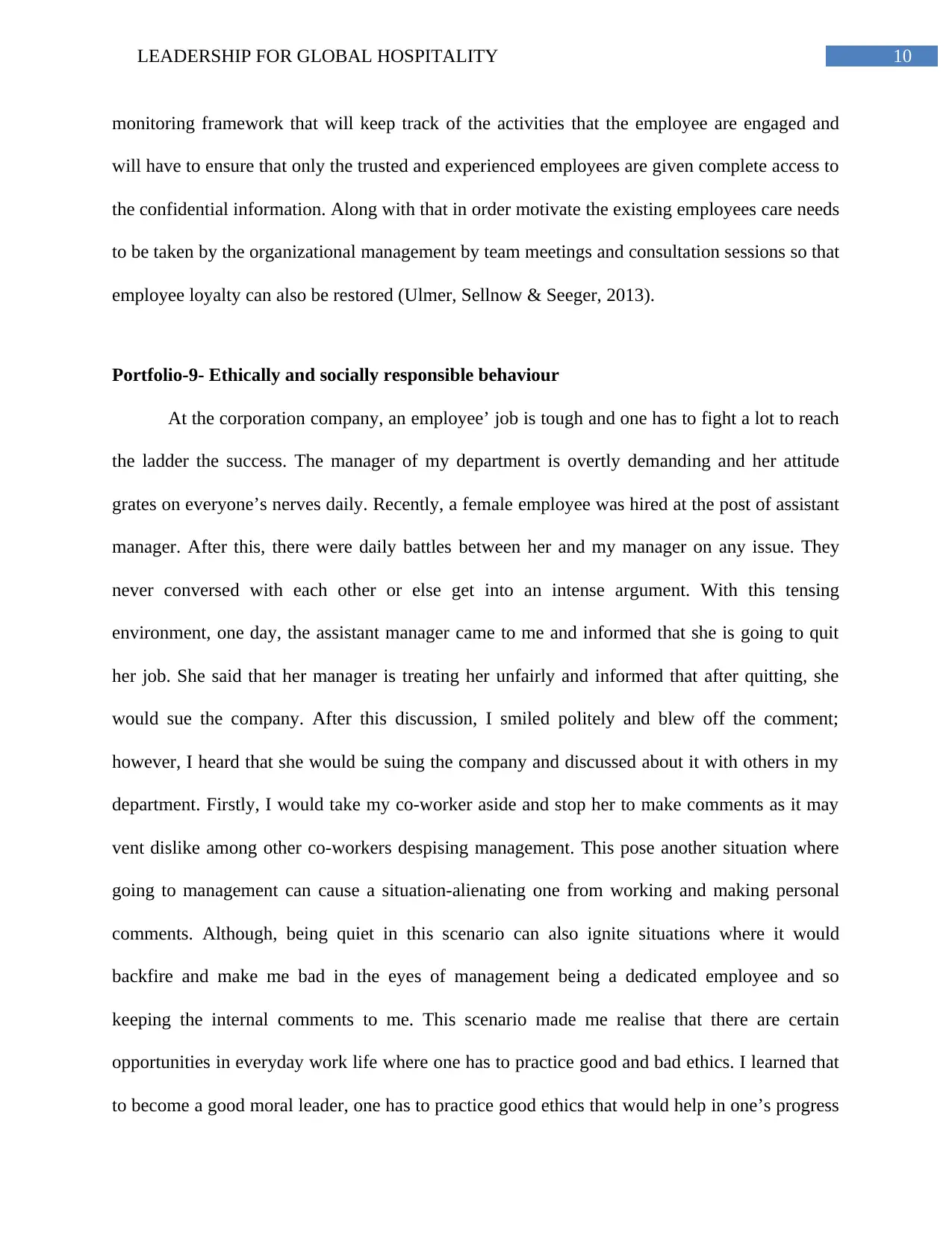
10LEADERSHIP FOR GLOBAL HOSPITALITY
monitoring framework that will keep track of the activities that the employee are engaged and
will have to ensure that only the trusted and experienced employees are given complete access to
the confidential information. Along with that in order motivate the existing employees care needs
to be taken by the organizational management by team meetings and consultation sessions so that
employee loyalty can also be restored (Ulmer, Sellnow & Seeger, 2013).
Portfolio-9- Ethically and socially responsible behaviour
At the corporation company, an employee’ job is tough and one has to fight a lot to reach
the ladder the success. The manager of my department is overtly demanding and her attitude
grates on everyone’s nerves daily. Recently, a female employee was hired at the post of assistant
manager. After this, there were daily battles between her and my manager on any issue. They
never conversed with each other or else get into an intense argument. With this tensing
environment, one day, the assistant manager came to me and informed that she is going to quit
her job. She said that her manager is treating her unfairly and informed that after quitting, she
would sue the company. After this discussion, I smiled politely and blew off the comment;
however, I heard that she would be suing the company and discussed about it with others in my
department. Firstly, I would take my co-worker aside and stop her to make comments as it may
vent dislike among other co-workers despising management. This pose another situation where
going to management can cause a situation-alienating one from working and making personal
comments. Although, being quiet in this scenario can also ignite situations where it would
backfire and make me bad in the eyes of management being a dedicated employee and so
keeping the internal comments to me. This scenario made me realise that there are certain
opportunities in everyday work life where one has to practice good and bad ethics. I learned that
to become a good moral leader, one has to practice good ethics that would help in one’s progress
monitoring framework that will keep track of the activities that the employee are engaged and
will have to ensure that only the trusted and experienced employees are given complete access to
the confidential information. Along with that in order motivate the existing employees care needs
to be taken by the organizational management by team meetings and consultation sessions so that
employee loyalty can also be restored (Ulmer, Sellnow & Seeger, 2013).
Portfolio-9- Ethically and socially responsible behaviour
At the corporation company, an employee’ job is tough and one has to fight a lot to reach
the ladder the success. The manager of my department is overtly demanding and her attitude
grates on everyone’s nerves daily. Recently, a female employee was hired at the post of assistant
manager. After this, there were daily battles between her and my manager on any issue. They
never conversed with each other or else get into an intense argument. With this tensing
environment, one day, the assistant manager came to me and informed that she is going to quit
her job. She said that her manager is treating her unfairly and informed that after quitting, she
would sue the company. After this discussion, I smiled politely and blew off the comment;
however, I heard that she would be suing the company and discussed about it with others in my
department. Firstly, I would take my co-worker aside and stop her to make comments as it may
vent dislike among other co-workers despising management. This pose another situation where
going to management can cause a situation-alienating one from working and making personal
comments. Although, being quiet in this scenario can also ignite situations where it would
backfire and make me bad in the eyes of management being a dedicated employee and so
keeping the internal comments to me. This scenario made me realise that there are certain
opportunities in everyday work life where one has to practice good and bad ethics. I learned that
to become a good moral leader, one has to practice good ethics that would help in one’s progress
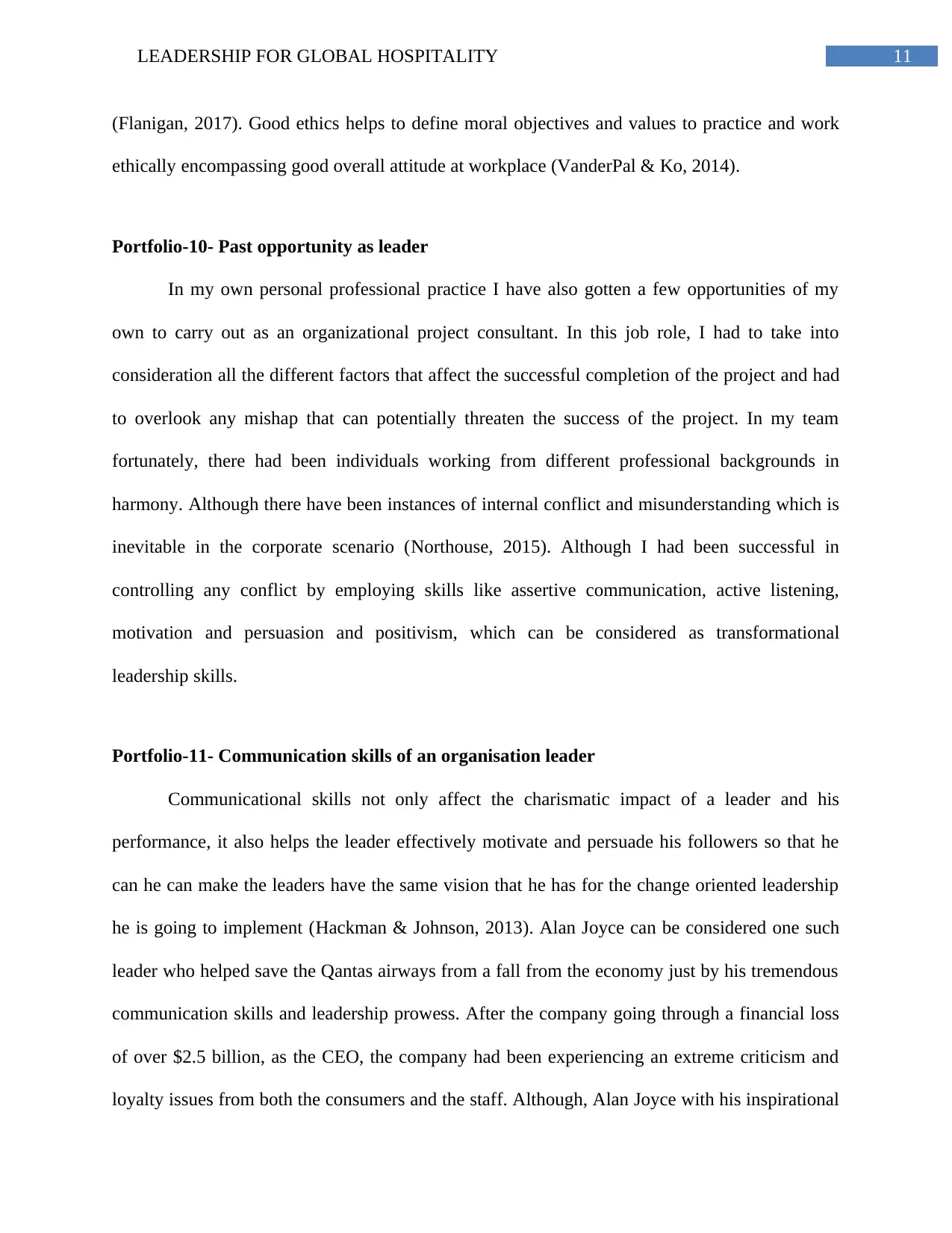
11LEADERSHIP FOR GLOBAL HOSPITALITY
(Flanigan, 2017). Good ethics helps to define moral objectives and values to practice and work
ethically encompassing good overall attitude at workplace (VanderPal & Ko, 2014).
Portfolio-10- Past opportunity as leader
In my own personal professional practice I have also gotten a few opportunities of my
own to carry out as an organizational project consultant. In this job role, I had to take into
consideration all the different factors that affect the successful completion of the project and had
to overlook any mishap that can potentially threaten the success of the project. In my team
fortunately, there had been individuals working from different professional backgrounds in
harmony. Although there have been instances of internal conflict and misunderstanding which is
inevitable in the corporate scenario (Northouse, 2015). Although I had been successful in
controlling any conflict by employing skills like assertive communication, active listening,
motivation and persuasion and positivism, which can be considered as transformational
leadership skills.
Portfolio-11- Communication skills of an organisation leader
Communicational skills not only affect the charismatic impact of a leader and his
performance, it also helps the leader effectively motivate and persuade his followers so that he
can he can make the leaders have the same vision that he has for the change oriented leadership
he is going to implement (Hackman & Johnson, 2013). Alan Joyce can be considered one such
leader who helped save the Qantas airways from a fall from the economy just by his tremendous
communication skills and leadership prowess. After the company going through a financial loss
of over $2.5 billion, as the CEO, the company had been experiencing an extreme criticism and
loyalty issues from both the consumers and the staff. Although, Alan Joyce with his inspirational
(Flanigan, 2017). Good ethics helps to define moral objectives and values to practice and work
ethically encompassing good overall attitude at workplace (VanderPal & Ko, 2014).
Portfolio-10- Past opportunity as leader
In my own personal professional practice I have also gotten a few opportunities of my
own to carry out as an organizational project consultant. In this job role, I had to take into
consideration all the different factors that affect the successful completion of the project and had
to overlook any mishap that can potentially threaten the success of the project. In my team
fortunately, there had been individuals working from different professional backgrounds in
harmony. Although there have been instances of internal conflict and misunderstanding which is
inevitable in the corporate scenario (Northouse, 2015). Although I had been successful in
controlling any conflict by employing skills like assertive communication, active listening,
motivation and persuasion and positivism, which can be considered as transformational
leadership skills.
Portfolio-11- Communication skills of an organisation leader
Communicational skills not only affect the charismatic impact of a leader and his
performance, it also helps the leader effectively motivate and persuade his followers so that he
can he can make the leaders have the same vision that he has for the change oriented leadership
he is going to implement (Hackman & Johnson, 2013). Alan Joyce can be considered one such
leader who helped save the Qantas airways from a fall from the economy just by his tremendous
communication skills and leadership prowess. After the company going through a financial loss
of over $2.5 billion, as the CEO, the company had been experiencing an extreme criticism and
loyalty issues from both the consumers and the staff. Although, Alan Joyce with his inspirational
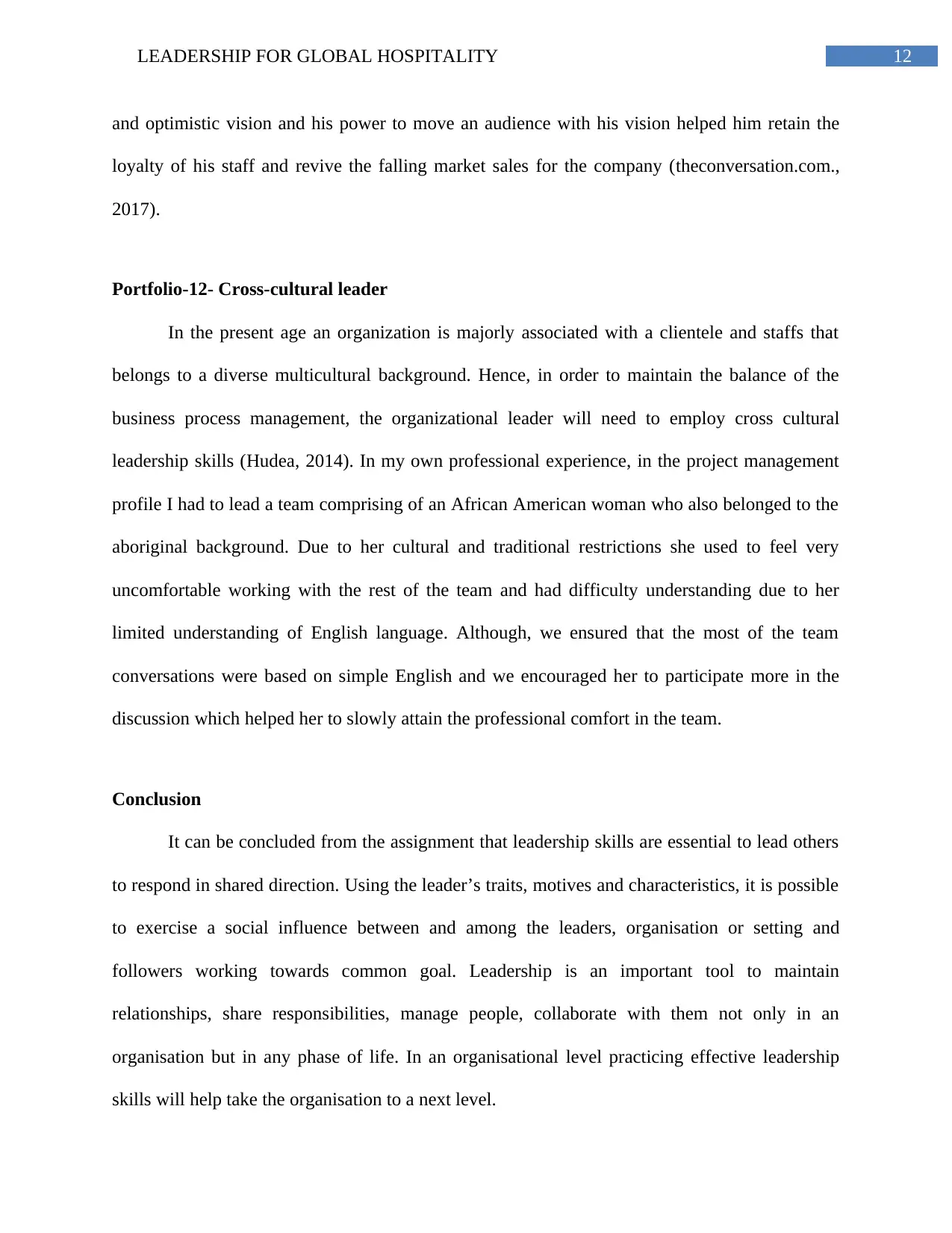
12LEADERSHIP FOR GLOBAL HOSPITALITY
and optimistic vision and his power to move an audience with his vision helped him retain the
loyalty of his staff and revive the falling market sales for the company (theconversation.com.,
2017).
Portfolio-12- Cross-cultural leader
In the present age an organization is majorly associated with a clientele and staffs that
belongs to a diverse multicultural background. Hence, in order to maintain the balance of the
business process management, the organizational leader will need to employ cross cultural
leadership skills (Hudea, 2014). In my own professional experience, in the project management
profile I had to lead a team comprising of an African American woman who also belonged to the
aboriginal background. Due to her cultural and traditional restrictions she used to feel very
uncomfortable working with the rest of the team and had difficulty understanding due to her
limited understanding of English language. Although, we ensured that the most of the team
conversations were based on simple English and we encouraged her to participate more in the
discussion which helped her to slowly attain the professional comfort in the team.
Conclusion
It can be concluded from the assignment that leadership skills are essential to lead others
to respond in shared direction. Using the leader’s traits, motives and characteristics, it is possible
to exercise a social influence between and among the leaders, organisation or setting and
followers working towards common goal. Leadership is an important tool to maintain
relationships, share responsibilities, manage people, collaborate with them not only in an
organisation but in any phase of life. In an organisational level practicing effective leadership
skills will help take the organisation to a next level.
and optimistic vision and his power to move an audience with his vision helped him retain the
loyalty of his staff and revive the falling market sales for the company (theconversation.com.,
2017).
Portfolio-12- Cross-cultural leader
In the present age an organization is majorly associated with a clientele and staffs that
belongs to a diverse multicultural background. Hence, in order to maintain the balance of the
business process management, the organizational leader will need to employ cross cultural
leadership skills (Hudea, 2014). In my own professional experience, in the project management
profile I had to lead a team comprising of an African American woman who also belonged to the
aboriginal background. Due to her cultural and traditional restrictions she used to feel very
uncomfortable working with the rest of the team and had difficulty understanding due to her
limited understanding of English language. Although, we ensured that the most of the team
conversations were based on simple English and we encouraged her to participate more in the
discussion which helped her to slowly attain the professional comfort in the team.
Conclusion
It can be concluded from the assignment that leadership skills are essential to lead others
to respond in shared direction. Using the leader’s traits, motives and characteristics, it is possible
to exercise a social influence between and among the leaders, organisation or setting and
followers working towards common goal. Leadership is an important tool to maintain
relationships, share responsibilities, manage people, collaborate with them not only in an
organisation but in any phase of life. In an organisational level practicing effective leadership
skills will help take the organisation to a next level.
Secure Best Marks with AI Grader
Need help grading? Try our AI Grader for instant feedback on your assignments.
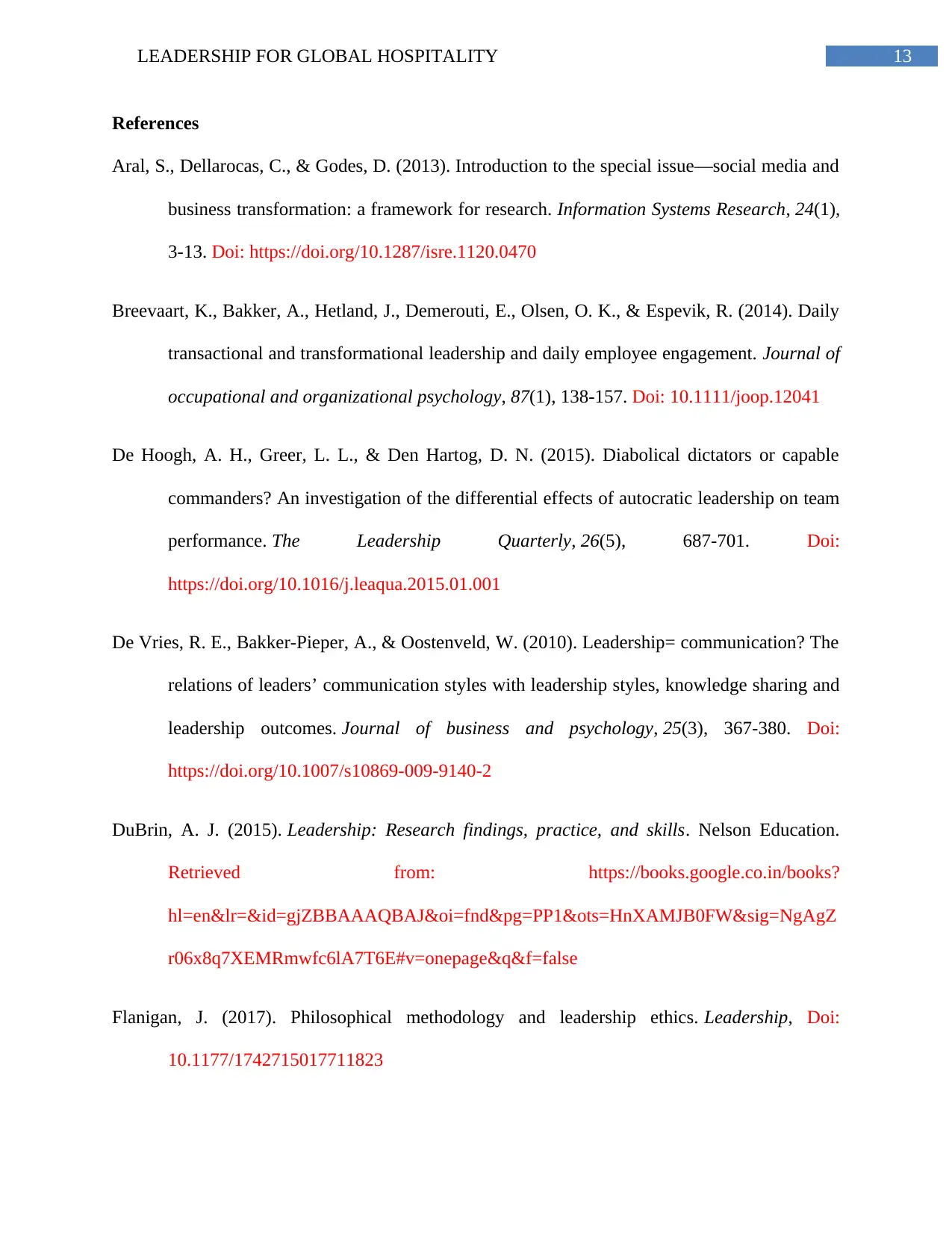
13LEADERSHIP FOR GLOBAL HOSPITALITY
References
Aral, S., Dellarocas, C., & Godes, D. (2013). Introduction to the special issue—social media and
business transformation: a framework for research. Information Systems Research, 24(1),
3-13. Doi: https://doi.org/10.1287/isre.1120.0470
Breevaart, K., Bakker, A., Hetland, J., Demerouti, E., Olsen, O. K., & Espevik, R. (2014). Daily
transactional and transformational leadership and daily employee engagement. Journal of
occupational and organizational psychology, 87(1), 138-157. Doi: 10.1111/joop.12041
De Hoogh, A. H., Greer, L. L., & Den Hartog, D. N. (2015). Diabolical dictators or capable
commanders? An investigation of the differential effects of autocratic leadership on team
performance. The Leadership Quarterly, 26(5), 687-701. Doi:
https://doi.org/10.1016/j.leaqua.2015.01.001
De Vries, R. E., Bakker-Pieper, A., & Oostenveld, W. (2010). Leadership= communication? The
relations of leaders’ communication styles with leadership styles, knowledge sharing and
leadership outcomes. Journal of business and psychology, 25(3), 367-380. Doi:
https://doi.org/10.1007/s10869-009-9140-2
DuBrin, A. J. (2015). Leadership: Research findings, practice, and skills. Nelson Education.
Retrieved from: https://books.google.co.in/books?
hl=en&lr=&id=gjZBBAAAQBAJ&oi=fnd&pg=PP1&ots=HnXAMJB0FW&sig=NgAgZ
r06x8q7XEMRmwfc6lA7T6E#v=onepage&q&f=false
Flanigan, J. (2017). Philosophical methodology and leadership ethics. Leadership, Doi:
10.1177/1742715017711823
References
Aral, S., Dellarocas, C., & Godes, D. (2013). Introduction to the special issue—social media and
business transformation: a framework for research. Information Systems Research, 24(1),
3-13. Doi: https://doi.org/10.1287/isre.1120.0470
Breevaart, K., Bakker, A., Hetland, J., Demerouti, E., Olsen, O. K., & Espevik, R. (2014). Daily
transactional and transformational leadership and daily employee engagement. Journal of
occupational and organizational psychology, 87(1), 138-157. Doi: 10.1111/joop.12041
De Hoogh, A. H., Greer, L. L., & Den Hartog, D. N. (2015). Diabolical dictators or capable
commanders? An investigation of the differential effects of autocratic leadership on team
performance. The Leadership Quarterly, 26(5), 687-701. Doi:
https://doi.org/10.1016/j.leaqua.2015.01.001
De Vries, R. E., Bakker-Pieper, A., & Oostenveld, W. (2010). Leadership= communication? The
relations of leaders’ communication styles with leadership styles, knowledge sharing and
leadership outcomes. Journal of business and psychology, 25(3), 367-380. Doi:
https://doi.org/10.1007/s10869-009-9140-2
DuBrin, A. J. (2015). Leadership: Research findings, practice, and skills. Nelson Education.
Retrieved from: https://books.google.co.in/books?
hl=en&lr=&id=gjZBBAAAQBAJ&oi=fnd&pg=PP1&ots=HnXAMJB0FW&sig=NgAgZ
r06x8q7XEMRmwfc6lA7T6E#v=onepage&q&f=false
Flanigan, J. (2017). Philosophical methodology and leadership ethics. Leadership, Doi:
10.1177/1742715017711823
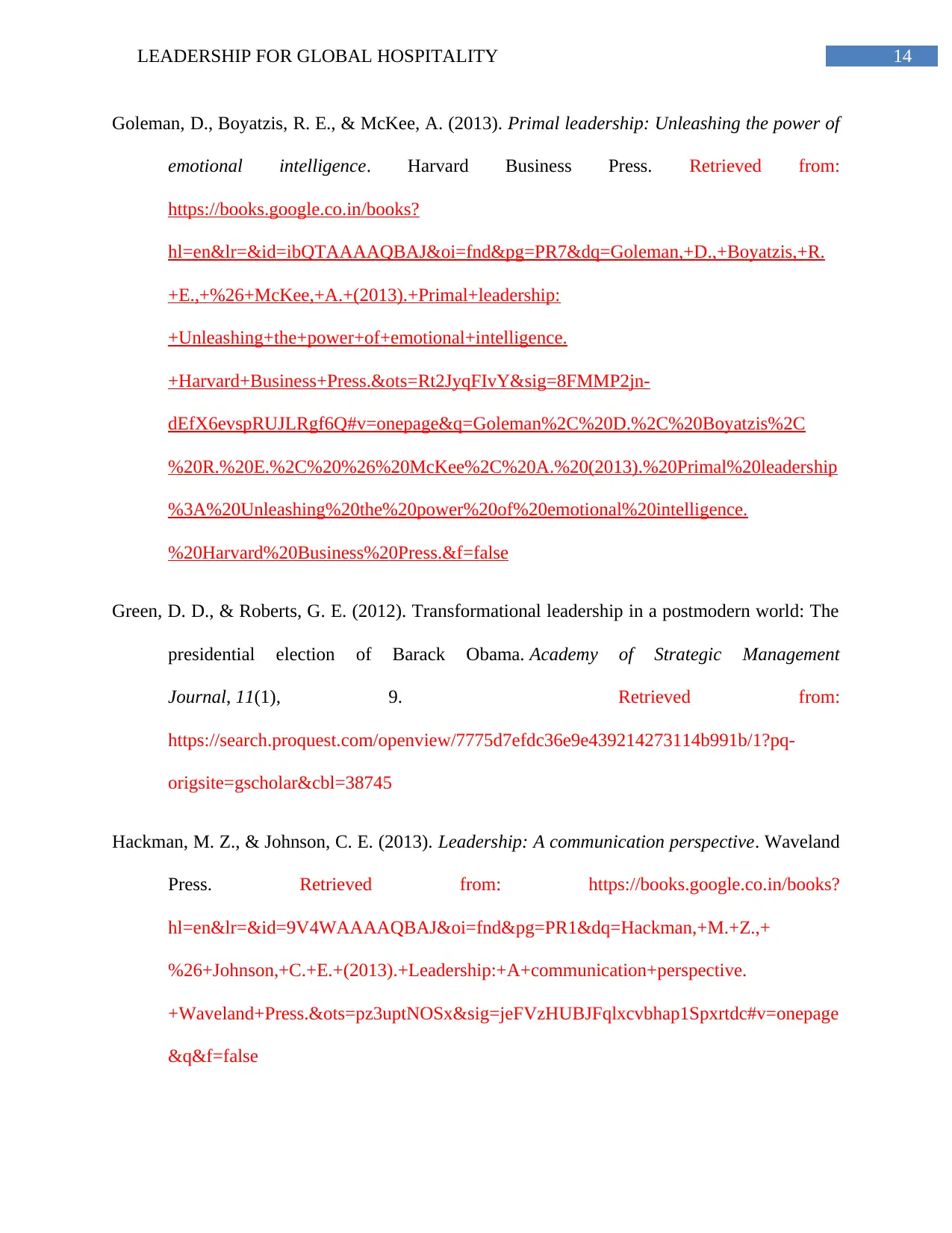
14LEADERSHIP FOR GLOBAL HOSPITALITY
Goleman, D., Boyatzis, R. E., & McKee, A. (2013). Primal leadership: Unleashing the power of
emotional intelligence. Harvard Business Press. Retrieved from:
https://books.google.co.in/books?
hl=en&lr=&id=ibQTAAAAQBAJ&oi=fnd&pg=PR7&dq=Goleman,+D.,+Boyatzis,+R.
+E.,+%26+McKee,+A.+(2013).+Primal+leadership:
+Unleashing+the+power+of+emotional+intelligence.
+Harvard+Business+Press.&ots=Rt2JyqFIvY&sig=8FMMP2jn-
dEfX6evspRUJLRgf6Q#v=onepage&q=Goleman%2C%20D.%2C%20Boyatzis%2C
%20R.%20E.%2C%20%26%20McKee%2C%20A.%20(2013).%20Primal%20leadership
%3A%20Unleashing%20the%20power%20of%20emotional%20intelligence.
%20Harvard%20Business%20Press.&f=false
Green, D. D., & Roberts, G. E. (2012). Transformational leadership in a postmodern world: The
presidential election of Barack Obama. Academy of Strategic Management
Journal, 11(1), 9. Retrieved from:
https://search.proquest.com/openview/7775d7efdc36e9e439214273114b991b/1?pq-
origsite=gscholar&cbl=38745
Hackman, M. Z., & Johnson, C. E. (2013). Leadership: A communication perspective. Waveland
Press. Retrieved from: https://books.google.co.in/books?
hl=en&lr=&id=9V4WAAAAQBAJ&oi=fnd&pg=PR1&dq=Hackman,+M.+Z.,+
%26+Johnson,+C.+E.+(2013).+Leadership:+A+communication+perspective.
+Waveland+Press.&ots=pz3uptNOSx&sig=jeFVzHUBJFqlxcvbhap1Spxrtdc#v=onepage
&q&f=false
Goleman, D., Boyatzis, R. E., & McKee, A. (2013). Primal leadership: Unleashing the power of
emotional intelligence. Harvard Business Press. Retrieved from:
https://books.google.co.in/books?
hl=en&lr=&id=ibQTAAAAQBAJ&oi=fnd&pg=PR7&dq=Goleman,+D.,+Boyatzis,+R.
+E.,+%26+McKee,+A.+(2013).+Primal+leadership:
+Unleashing+the+power+of+emotional+intelligence.
+Harvard+Business+Press.&ots=Rt2JyqFIvY&sig=8FMMP2jn-
dEfX6evspRUJLRgf6Q#v=onepage&q=Goleman%2C%20D.%2C%20Boyatzis%2C
%20R.%20E.%2C%20%26%20McKee%2C%20A.%20(2013).%20Primal%20leadership
%3A%20Unleashing%20the%20power%20of%20emotional%20intelligence.
%20Harvard%20Business%20Press.&f=false
Green, D. D., & Roberts, G. E. (2012). Transformational leadership in a postmodern world: The
presidential election of Barack Obama. Academy of Strategic Management
Journal, 11(1), 9. Retrieved from:
https://search.proquest.com/openview/7775d7efdc36e9e439214273114b991b/1?pq-
origsite=gscholar&cbl=38745
Hackman, M. Z., & Johnson, C. E. (2013). Leadership: A communication perspective. Waveland
Press. Retrieved from: https://books.google.co.in/books?
hl=en&lr=&id=9V4WAAAAQBAJ&oi=fnd&pg=PR1&dq=Hackman,+M.+Z.,+
%26+Johnson,+C.+E.+(2013).+Leadership:+A+communication+perspective.
+Waveland+Press.&ots=pz3uptNOSx&sig=jeFVzHUBJFqlxcvbhap1Spxrtdc#v=onepage
&q&f=false

15LEADERSHIP FOR GLOBAL HOSPITALITY
Hudea, O. S. (2014). Cross-cultural leadership. Manager, (19), 45. Retrieved from:
https://search.proquest.com/openview/da555a0cd04ccd92206fe98875bf178c/1?pq-
origsite=gscholar&cbl=2032296
Kark, R., & Shamir, B. (2013). The dual effect of transformational leadership: Priming relational
and collective selves and further effects on followers. In Transformational and
Charismatic Leadership: The Road Ahead 10th Anniversary Edition (pp. 77-101).
Emerald Group Publishing Limited. Doi: 10.1108/S1479-357120130000005010
Li, J., Zhang, J., & Yang, Z. (2017). Associations between a Leader's Work Passion and an
Employee's Work Passion: A Moderated Mediation Model. Frontiers in Psychology, 8,
1447. Doi: https://doi.org/10.3389/fpsyg.2017.01447
McCleskey, J. A. (2014). Situational, transformational, and transactional leadership and
leadership development. Journal of Business Studies Quarterly, 5(4), 117. Retrieved
from: https://search.proquest.com/openview/e03631119c37d022b66d4ea5fe176e3f/1?pq-
origsite=gscholar&cbl=1056382
Northouse, P. G. (2015). Leadership: Theory and practice. Sage publications. Retrieved from:
https://books.google.co.in/books?
hl=en&lr=&id=TuyeBgAAQBAJ&oi=fnd&pg=PT18&dq=Northouse,+P.+G.+(2015).
+Leadership:+Theory+and+practice.
+Sage+publications.&ots=mySEsD4N_e&sig=8b12v67l10hLzMWYVbzvrpK1EwE#v=
onepage&q=Northouse%2C%20P.%20G.%20(2015).%20Leadership%3A%20Theory
%20and%20practice.%20Sage%20publications.&f=false
Hudea, O. S. (2014). Cross-cultural leadership. Manager, (19), 45. Retrieved from:
https://search.proquest.com/openview/da555a0cd04ccd92206fe98875bf178c/1?pq-
origsite=gscholar&cbl=2032296
Kark, R., & Shamir, B. (2013). The dual effect of transformational leadership: Priming relational
and collective selves and further effects on followers. In Transformational and
Charismatic Leadership: The Road Ahead 10th Anniversary Edition (pp. 77-101).
Emerald Group Publishing Limited. Doi: 10.1108/S1479-357120130000005010
Li, J., Zhang, J., & Yang, Z. (2017). Associations between a Leader's Work Passion and an
Employee's Work Passion: A Moderated Mediation Model. Frontiers in Psychology, 8,
1447. Doi: https://doi.org/10.3389/fpsyg.2017.01447
McCleskey, J. A. (2014). Situational, transformational, and transactional leadership and
leadership development. Journal of Business Studies Quarterly, 5(4), 117. Retrieved
from: https://search.proquest.com/openview/e03631119c37d022b66d4ea5fe176e3f/1?pq-
origsite=gscholar&cbl=1056382
Northouse, P. G. (2015). Leadership: Theory and practice. Sage publications. Retrieved from:
https://books.google.co.in/books?
hl=en&lr=&id=TuyeBgAAQBAJ&oi=fnd&pg=PT18&dq=Northouse,+P.+G.+(2015).
+Leadership:+Theory+and+practice.
+Sage+publications.&ots=mySEsD4N_e&sig=8b12v67l10hLzMWYVbzvrpK1EwE#v=
onepage&q=Northouse%2C%20P.%20G.%20(2015).%20Leadership%3A%20Theory
%20and%20practice.%20Sage%20publications.&f=false
Paraphrase This Document
Need a fresh take? Get an instant paraphrase of this document with our AI Paraphraser

16LEADERSHIP FOR GLOBAL HOSPITALITY
Oreg, S., & Berson, Y. (2015). Personality and charismatic leadership in context: The
moderating role of situational stress. Personnel Psychology, 68(1), 49-77. Doi:
10.1111/peps.12073
Qantas turn-around: is Alan Joyce the right leader for the job?. (2017). The Conversation.
Retrieved 4 December 2017, from https://theconversation.com/qantas-turn-around-is-
alan-joyce-the-right-leader-for-the-job-31051
Rothman, N. B., & Melwani, S. (2017). Feeling mixed, ambivalent, and in flux: The social
functions of emotional complexity for leaders. Academy of Management Review, 42(2),
259-282. Doi: 10.5465/amr.2014.0355
Roueche, P. E., Baker III, G. A., & Rose, R. R. (2014). Shared vision: Transformational
leadership in American community colleges. Rowman & Littlefield. Retrieved from:
https://books.google.co.in/books?
hl=en&lr=&id=YKA_BAAAQBAJ&oi=fnd&pg=PR5&dq=Roueche,+P.+E.,+Baker+III,
+G.+A.,+%26+Rose,+R.+R.+(2014).+Shared+vision:
+Transformational+leadership+in+American+community+colleges.+Rowman+
%26+Littlefield.&ots=sUEdlAkEkF&sig=pNlQwuVUKhEPrNbvWQD0gwAx8AU#v=o
nepage&q&f=false
Schoemaker, P. J., Krupp, S., & Howland, S. (2013). Strategic leadership: The essential
skills. Harvard business review, 91(1), 131-134. Retrieved from:
https://www.researchgate.net/profile/Paul_Schoemaker/publication/235420822_Strategic
_leadership_The_essential_skills/links/0deec536ed20e0fac6000000/Strategic-leadership-
The-essential-skills.pdf
Oreg, S., & Berson, Y. (2015). Personality and charismatic leadership in context: The
moderating role of situational stress. Personnel Psychology, 68(1), 49-77. Doi:
10.1111/peps.12073
Qantas turn-around: is Alan Joyce the right leader for the job?. (2017). The Conversation.
Retrieved 4 December 2017, from https://theconversation.com/qantas-turn-around-is-
alan-joyce-the-right-leader-for-the-job-31051
Rothman, N. B., & Melwani, S. (2017). Feeling mixed, ambivalent, and in flux: The social
functions of emotional complexity for leaders. Academy of Management Review, 42(2),
259-282. Doi: 10.5465/amr.2014.0355
Roueche, P. E., Baker III, G. A., & Rose, R. R. (2014). Shared vision: Transformational
leadership in American community colleges. Rowman & Littlefield. Retrieved from:
https://books.google.co.in/books?
hl=en&lr=&id=YKA_BAAAQBAJ&oi=fnd&pg=PR5&dq=Roueche,+P.+E.,+Baker+III,
+G.+A.,+%26+Rose,+R.+R.+(2014).+Shared+vision:
+Transformational+leadership+in+American+community+colleges.+Rowman+
%26+Littlefield.&ots=sUEdlAkEkF&sig=pNlQwuVUKhEPrNbvWQD0gwAx8AU#v=o
nepage&q&f=false
Schoemaker, P. J., Krupp, S., & Howland, S. (2013). Strategic leadership: The essential
skills. Harvard business review, 91(1), 131-134. Retrieved from:
https://www.researchgate.net/profile/Paul_Schoemaker/publication/235420822_Strategic
_leadership_The_essential_skills/links/0deec536ed20e0fac6000000/Strategic-leadership-
The-essential-skills.pdf
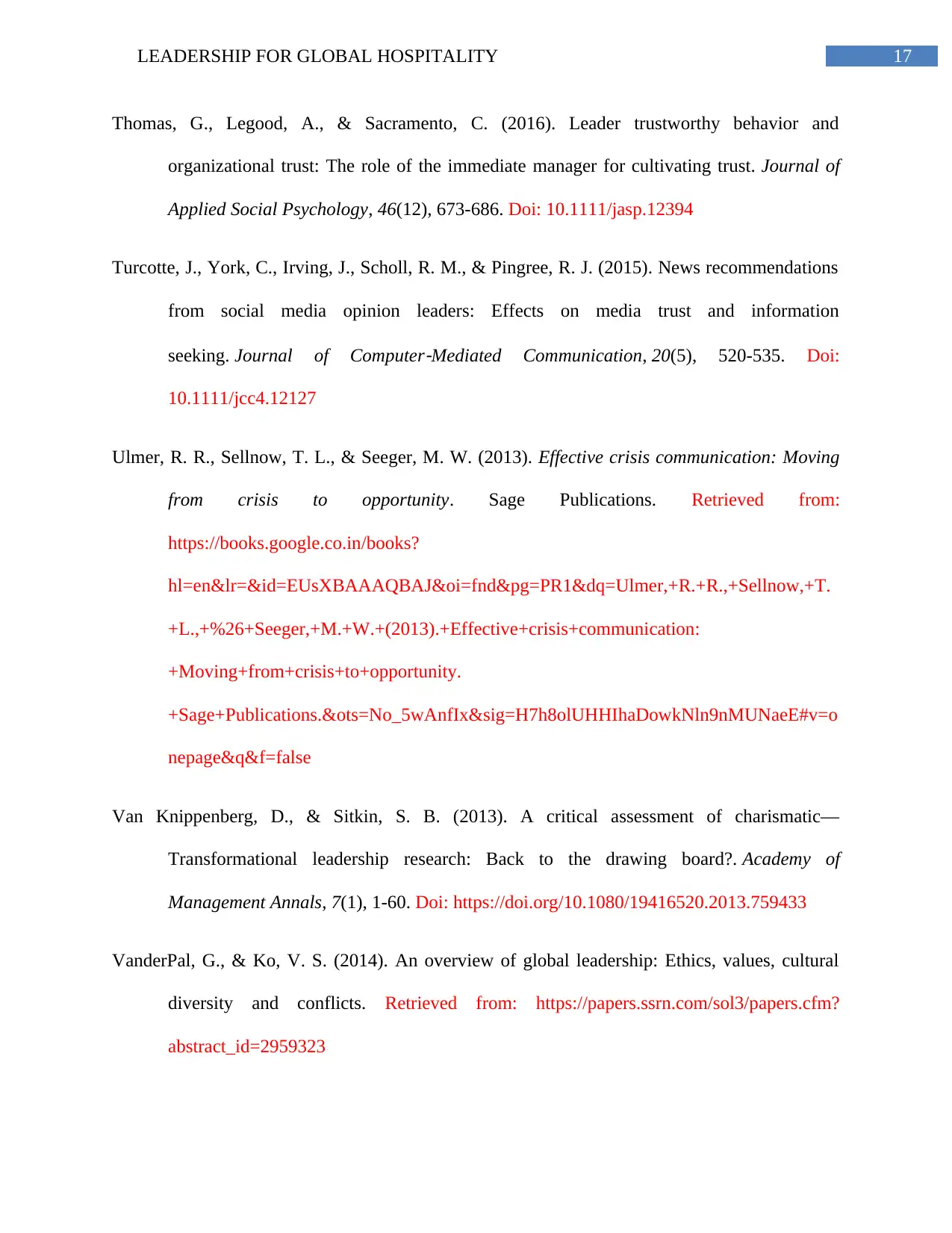
17LEADERSHIP FOR GLOBAL HOSPITALITY
Thomas, G., Legood, A., & Sacramento, C. (2016). Leader trustworthy behavior and
organizational trust: The role of the immediate manager for cultivating trust. Journal of
Applied Social Psychology, 46(12), 673-686. Doi: 10.1111/jasp.12394
Turcotte, J., York, C., Irving, J., Scholl, R. M., & Pingree, R. J. (2015). News recommendations
from social media opinion leaders: Effects on media trust and information
seeking. Journal of Computer
‐Mediated Communication, 20(5), 520-535. Doi:
10.1111/jcc4.12127
Ulmer, R. R., Sellnow, T. L., & Seeger, M. W. (2013). Effective crisis communication: Moving
from crisis to opportunity. Sage Publications. Retrieved from:
https://books.google.co.in/books?
hl=en&lr=&id=EUsXBAAAQBAJ&oi=fnd&pg=PR1&dq=Ulmer,+R.+R.,+Sellnow,+T.
+L.,+%26+Seeger,+M.+W.+(2013).+Effective+crisis+communication:
+Moving+from+crisis+to+opportunity.
+Sage+Publications.&ots=No_5wAnfIx&sig=H7h8olUHHIhaDowkNln9nMUNaeE#v=o
nepage&q&f=false
Van Knippenberg, D., & Sitkin, S. B. (2013). A critical assessment of charismatic—
Transformational leadership research: Back to the drawing board?. Academy of
Management Annals, 7(1), 1-60. Doi: https://doi.org/10.1080/19416520.2013.759433
VanderPal, G., & Ko, V. S. (2014). An overview of global leadership: Ethics, values, cultural
diversity and conflicts. Retrieved from: https://papers.ssrn.com/sol3/papers.cfm?
abstract_id=2959323
Thomas, G., Legood, A., & Sacramento, C. (2016). Leader trustworthy behavior and
organizational trust: The role of the immediate manager for cultivating trust. Journal of
Applied Social Psychology, 46(12), 673-686. Doi: 10.1111/jasp.12394
Turcotte, J., York, C., Irving, J., Scholl, R. M., & Pingree, R. J. (2015). News recommendations
from social media opinion leaders: Effects on media trust and information
seeking. Journal of Computer
‐Mediated Communication, 20(5), 520-535. Doi:
10.1111/jcc4.12127
Ulmer, R. R., Sellnow, T. L., & Seeger, M. W. (2013). Effective crisis communication: Moving
from crisis to opportunity. Sage Publications. Retrieved from:
https://books.google.co.in/books?
hl=en&lr=&id=EUsXBAAAQBAJ&oi=fnd&pg=PR1&dq=Ulmer,+R.+R.,+Sellnow,+T.
+L.,+%26+Seeger,+M.+W.+(2013).+Effective+crisis+communication:
+Moving+from+crisis+to+opportunity.
+Sage+Publications.&ots=No_5wAnfIx&sig=H7h8olUHHIhaDowkNln9nMUNaeE#v=o
nepage&q&f=false
Van Knippenberg, D., & Sitkin, S. B. (2013). A critical assessment of charismatic—
Transformational leadership research: Back to the drawing board?. Academy of
Management Annals, 7(1), 1-60. Doi: https://doi.org/10.1080/19416520.2013.759433
VanderPal, G., & Ko, V. S. (2014). An overview of global leadership: Ethics, values, cultural
diversity and conflicts. Retrieved from: https://papers.ssrn.com/sol3/papers.cfm?
abstract_id=2959323
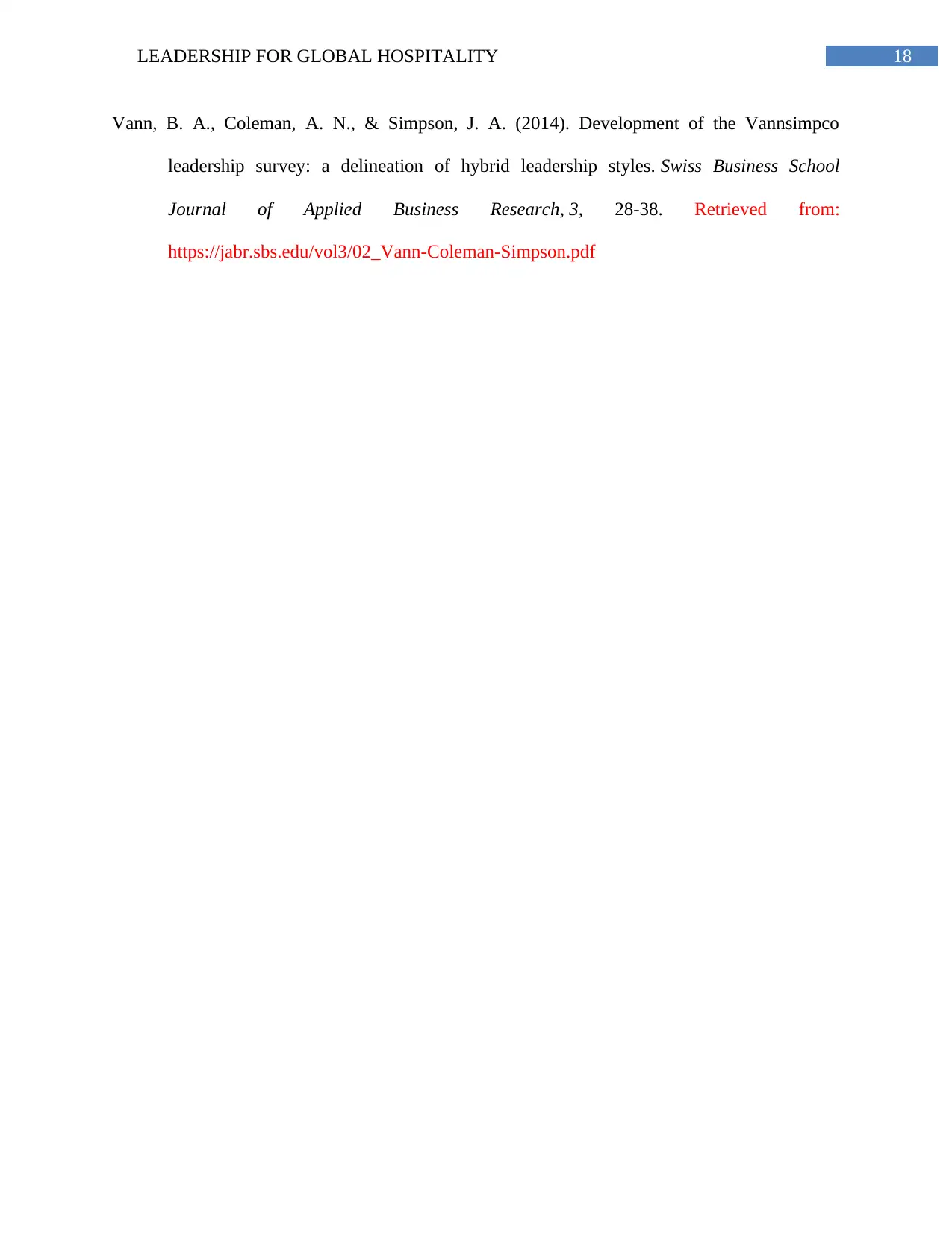
18LEADERSHIP FOR GLOBAL HOSPITALITY
Vann, B. A., Coleman, A. N., & Simpson, J. A. (2014). Development of the Vannsimpco
leadership survey: a delineation of hybrid leadership styles. Swiss Business School
Journal of Applied Business Research, 3, 28-38. Retrieved from:
https://jabr.sbs.edu/vol3/02_Vann-Coleman-Simpson.pdf
Vann, B. A., Coleman, A. N., & Simpson, J. A. (2014). Development of the Vannsimpco
leadership survey: a delineation of hybrid leadership styles. Swiss Business School
Journal of Applied Business Research, 3, 28-38. Retrieved from:
https://jabr.sbs.edu/vol3/02_Vann-Coleman-Simpson.pdf
1 out of 19
![[object Object]](/_next/static/media/star-bottom.7253800d.svg)





